
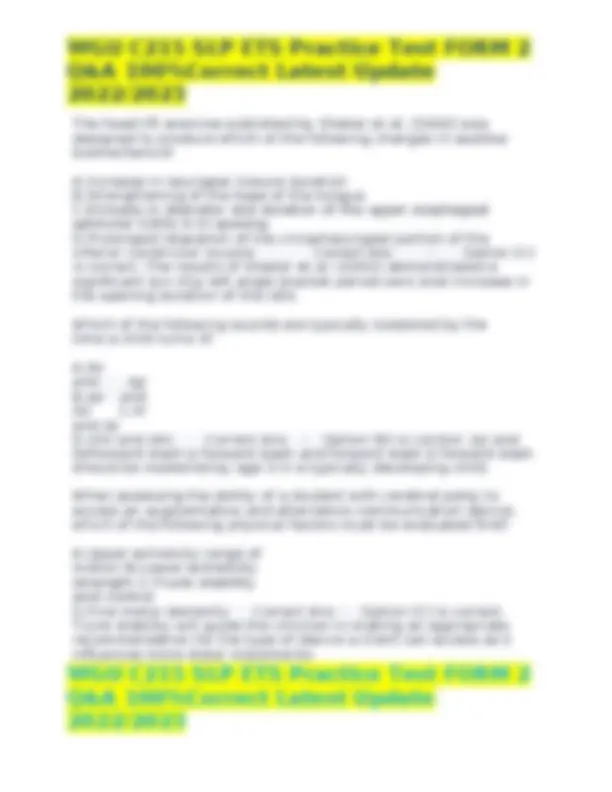
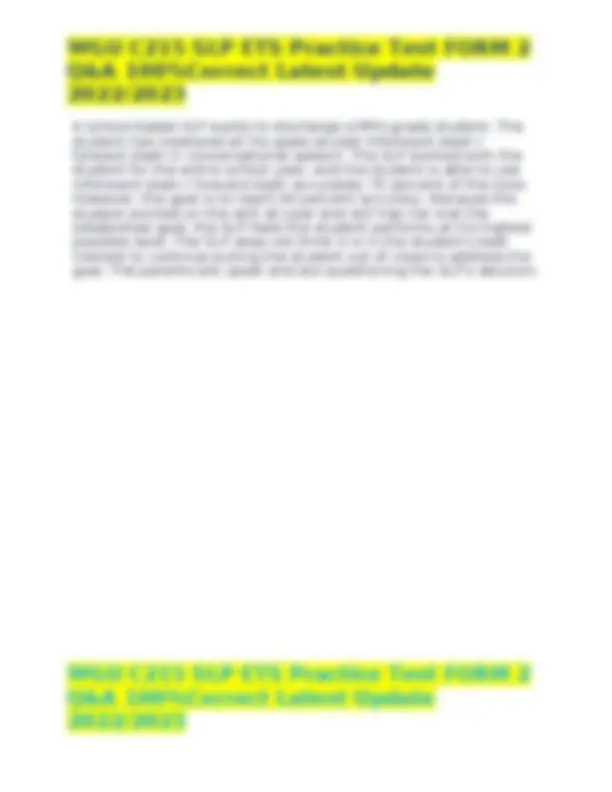
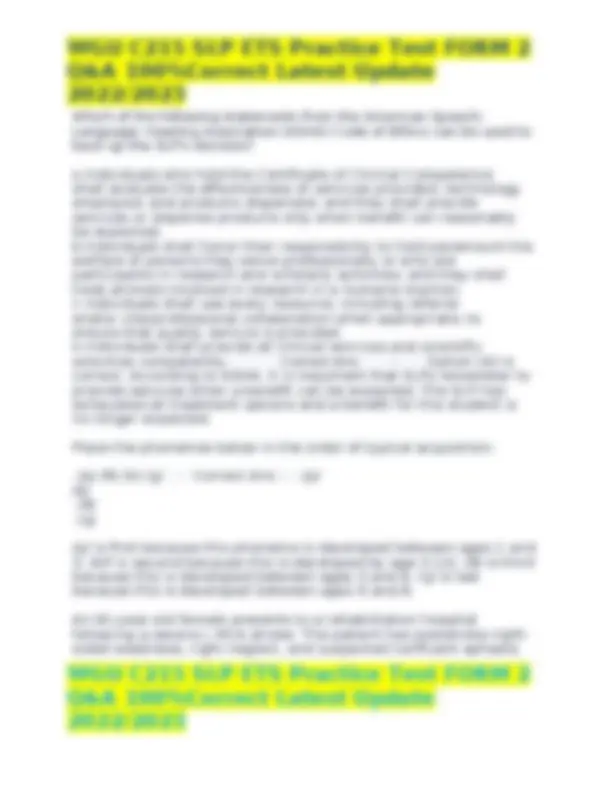
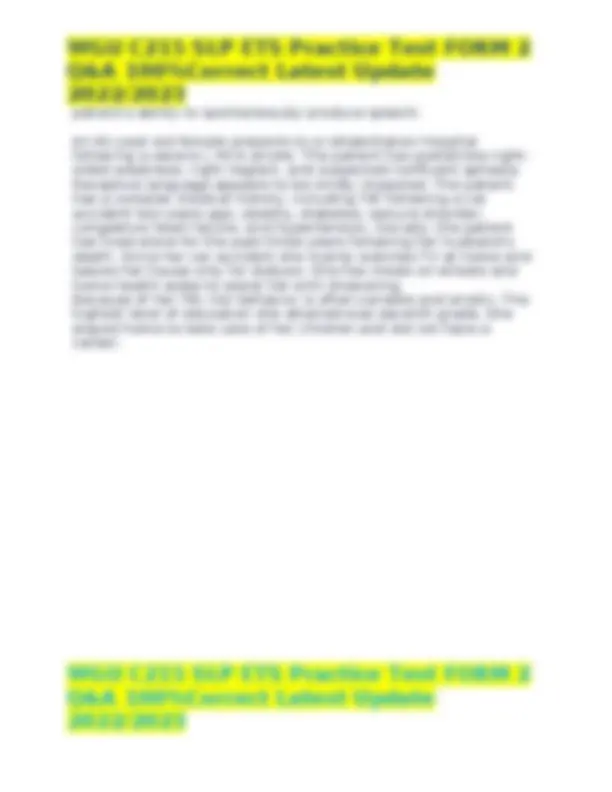
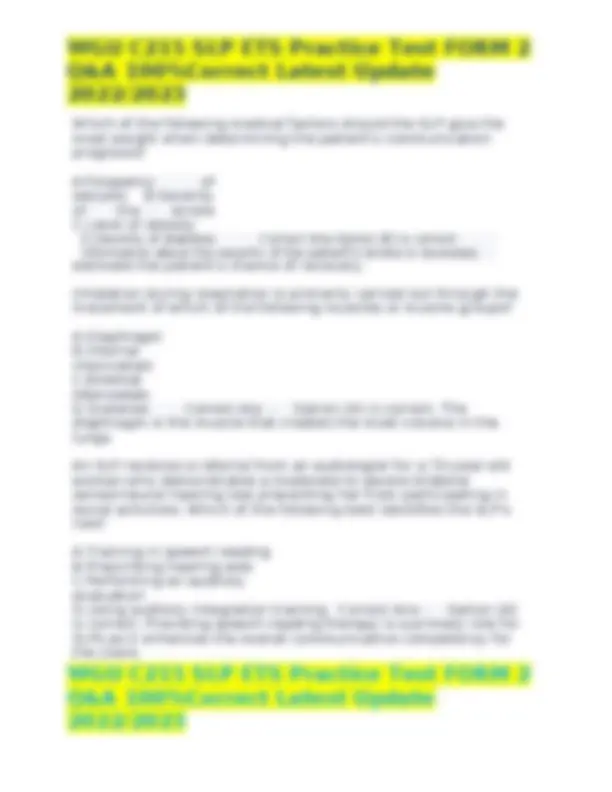
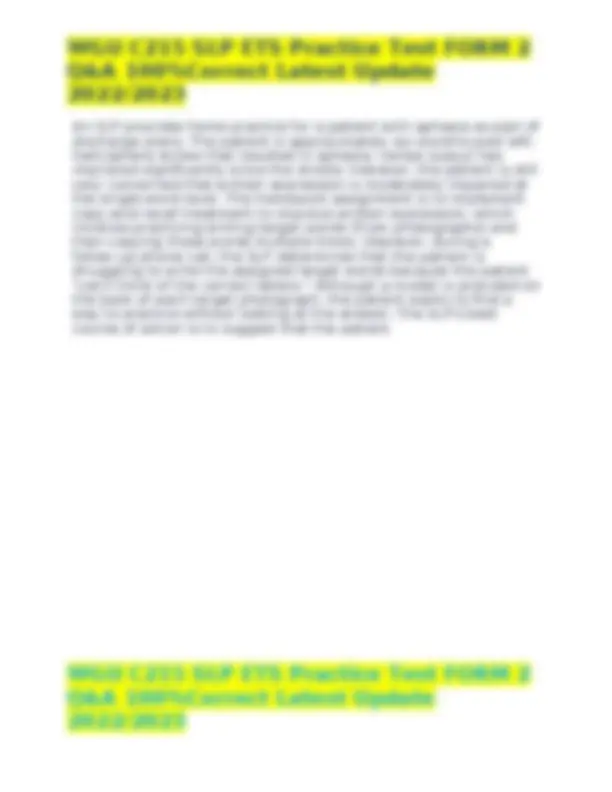
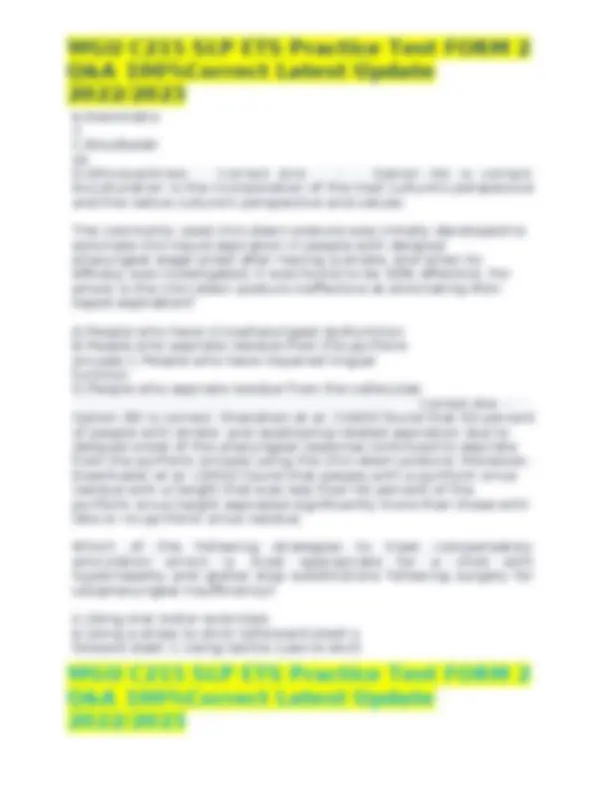
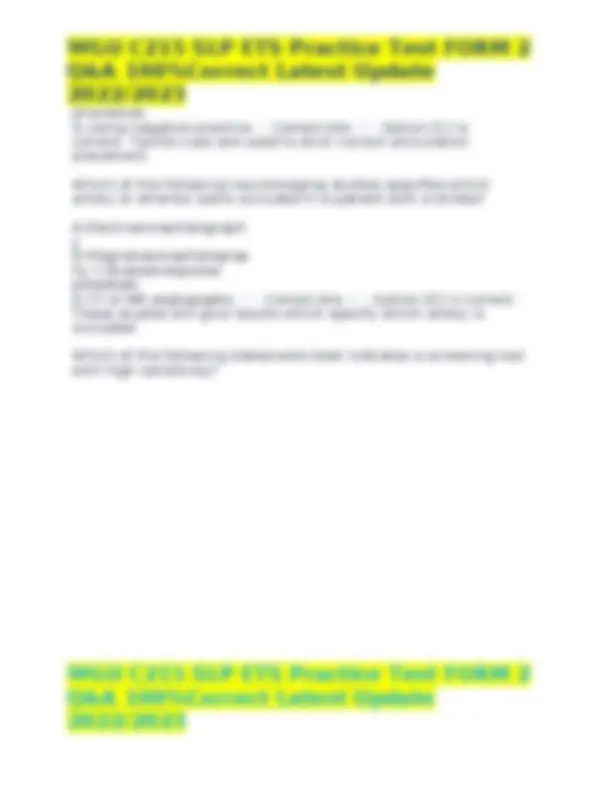
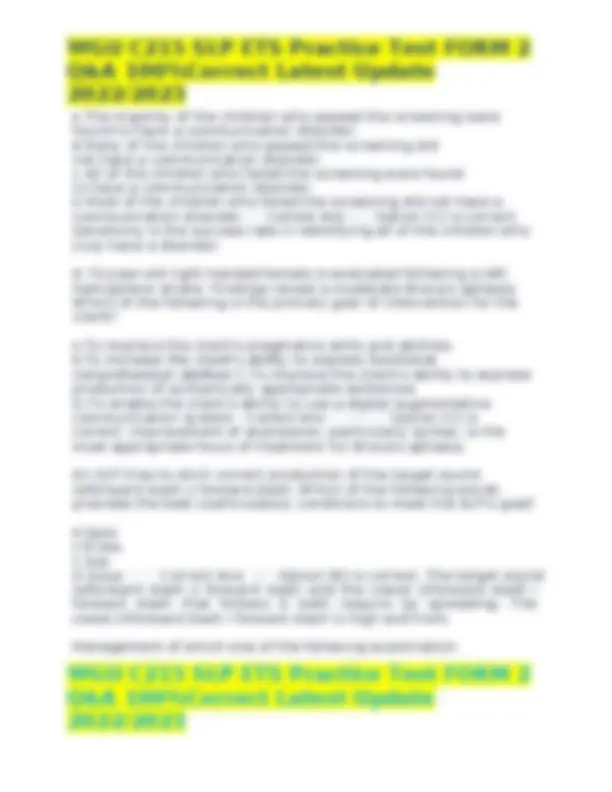
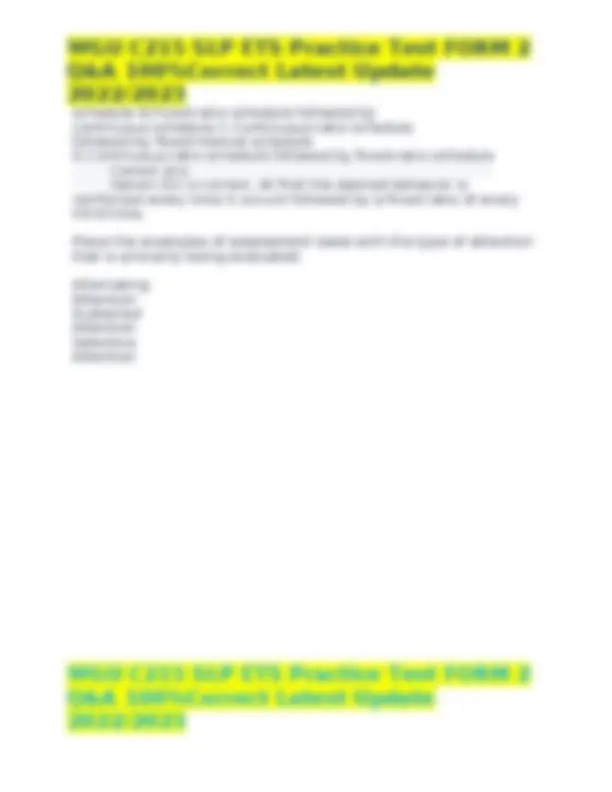
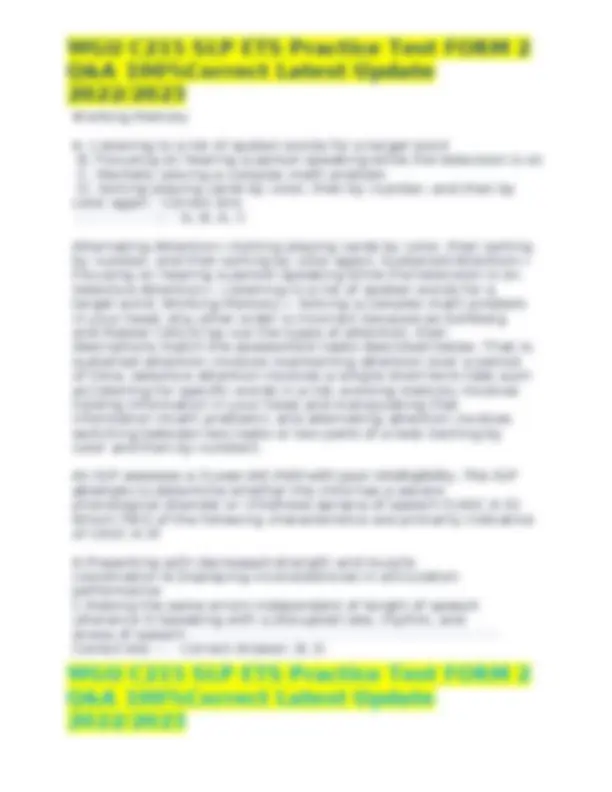

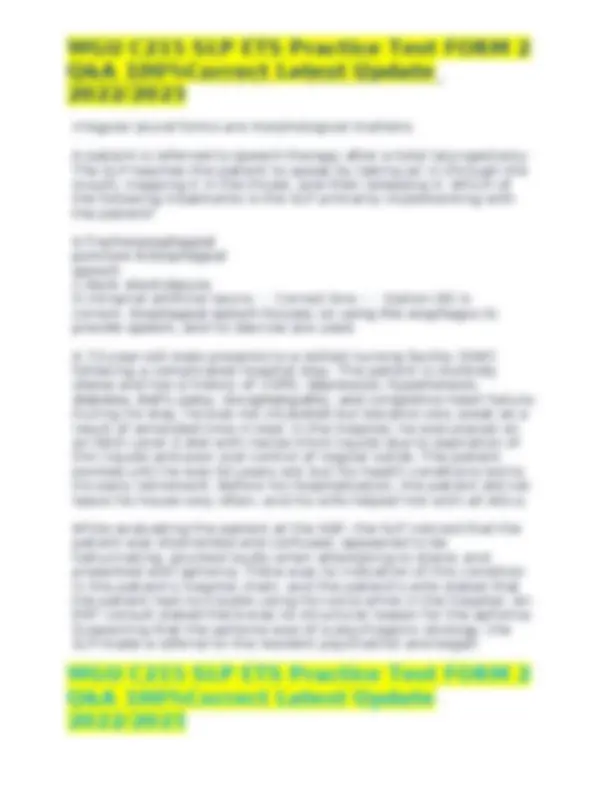
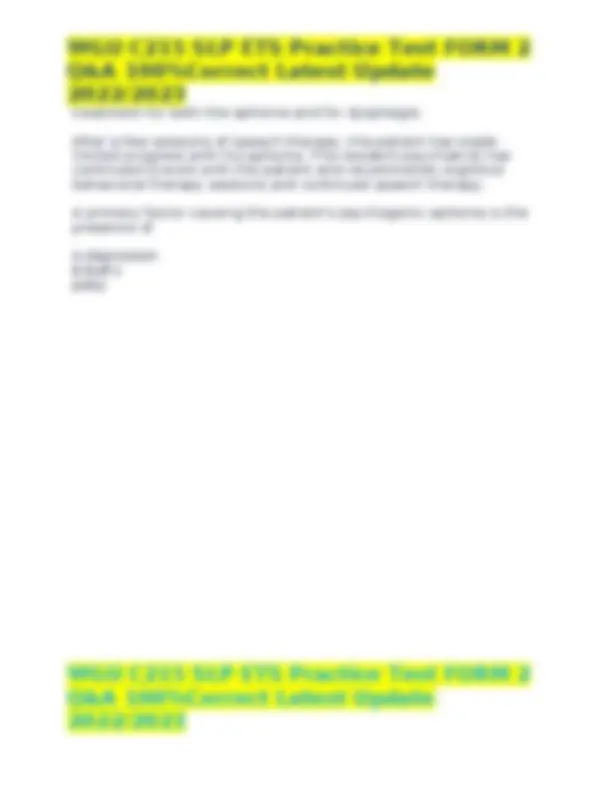
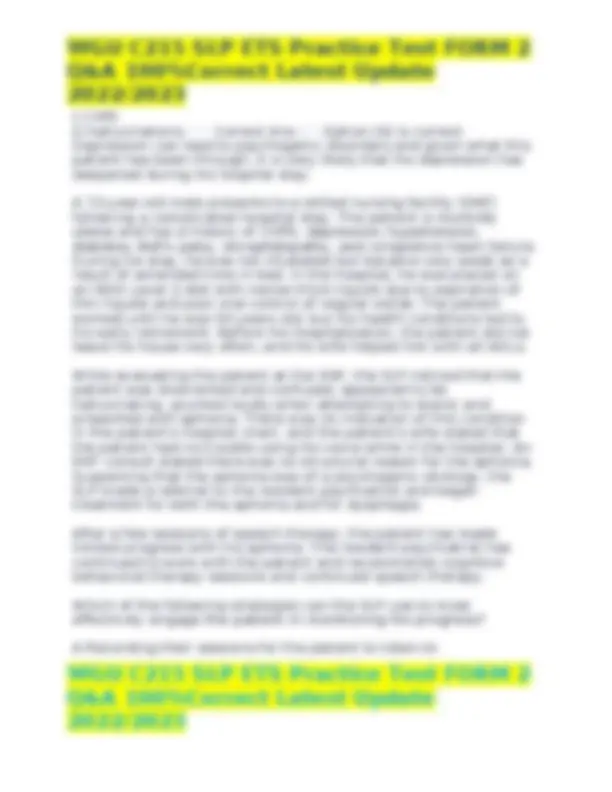
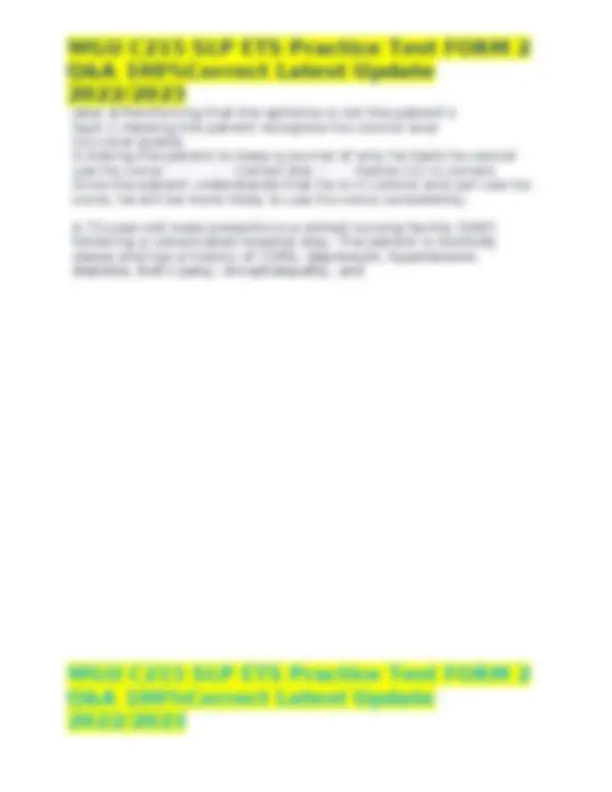
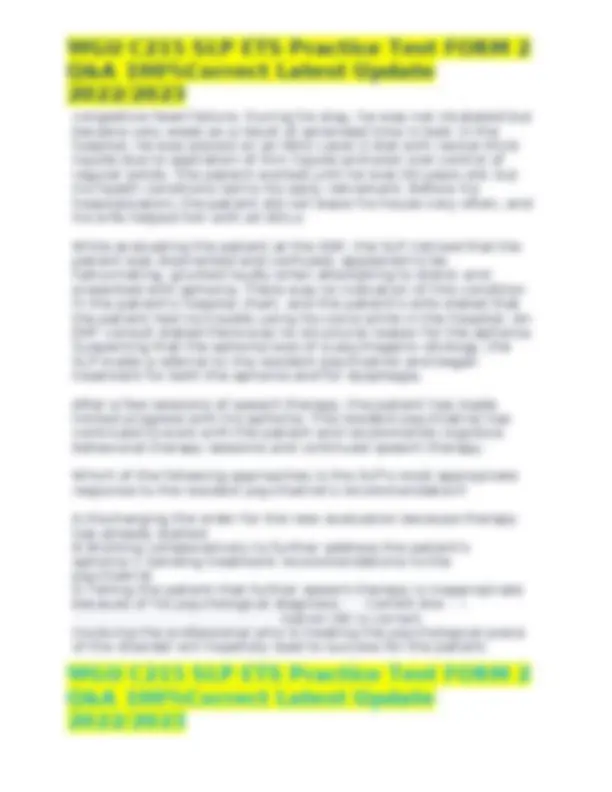
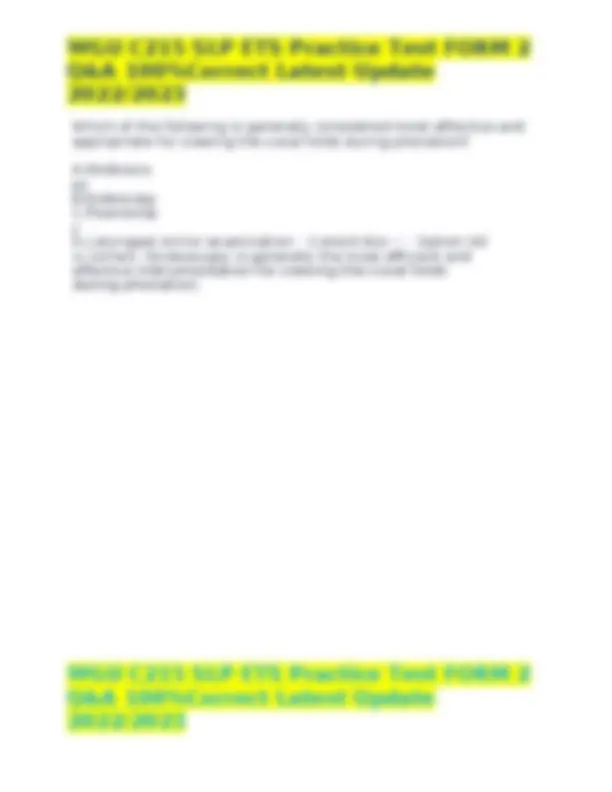
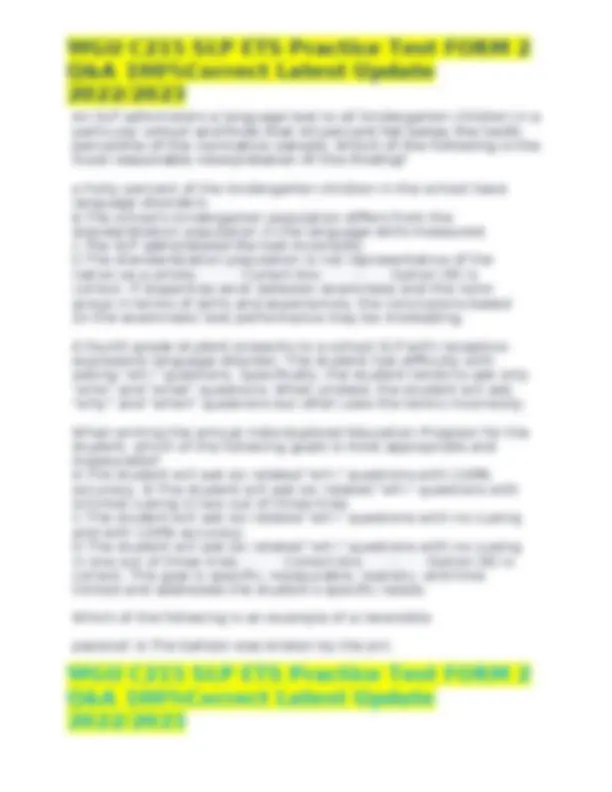
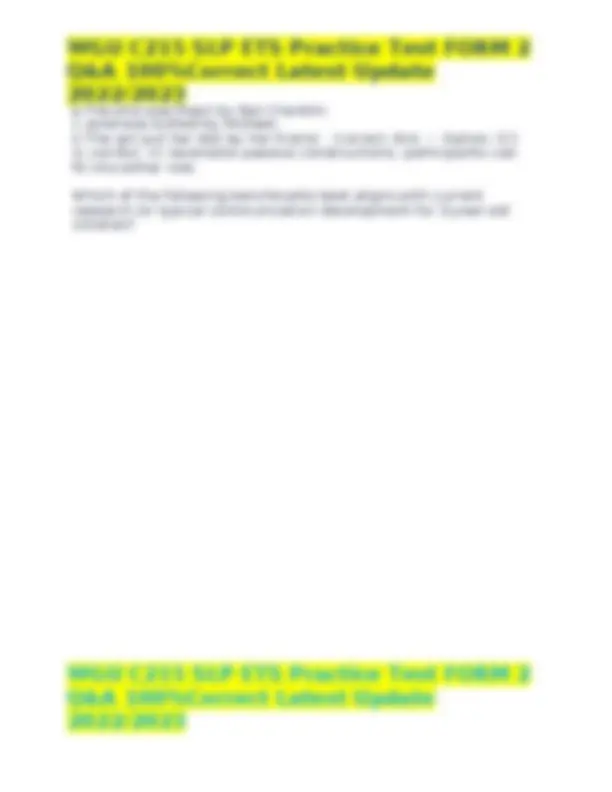
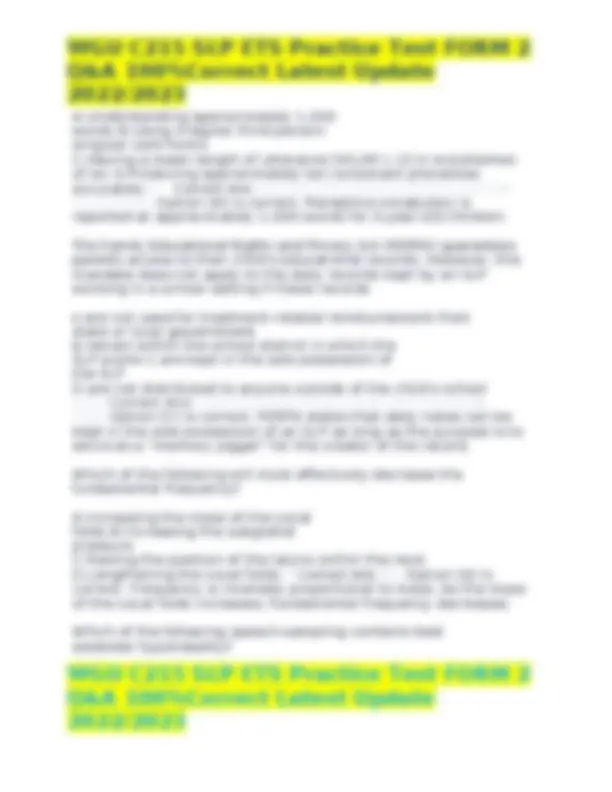
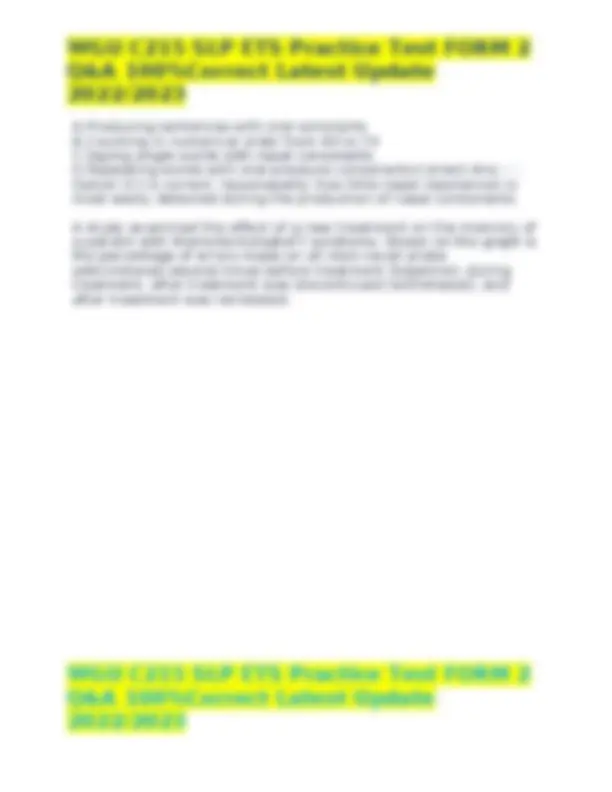
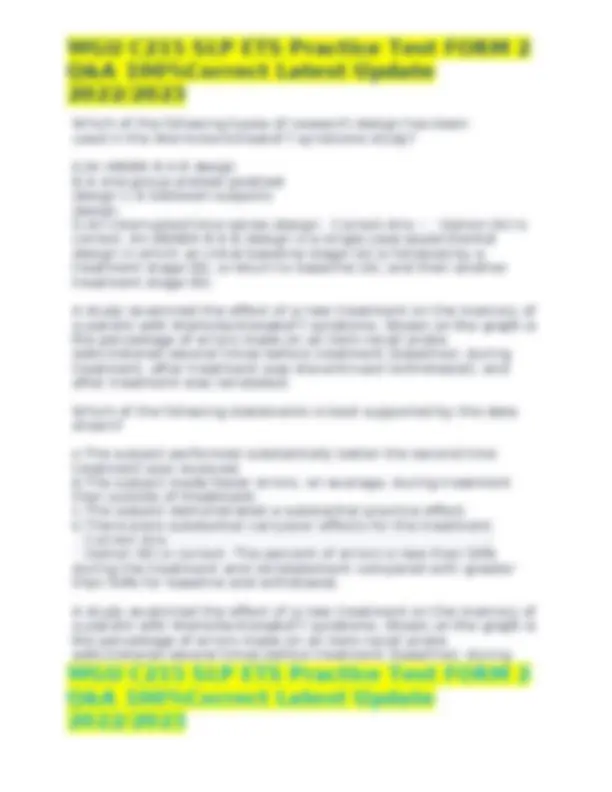
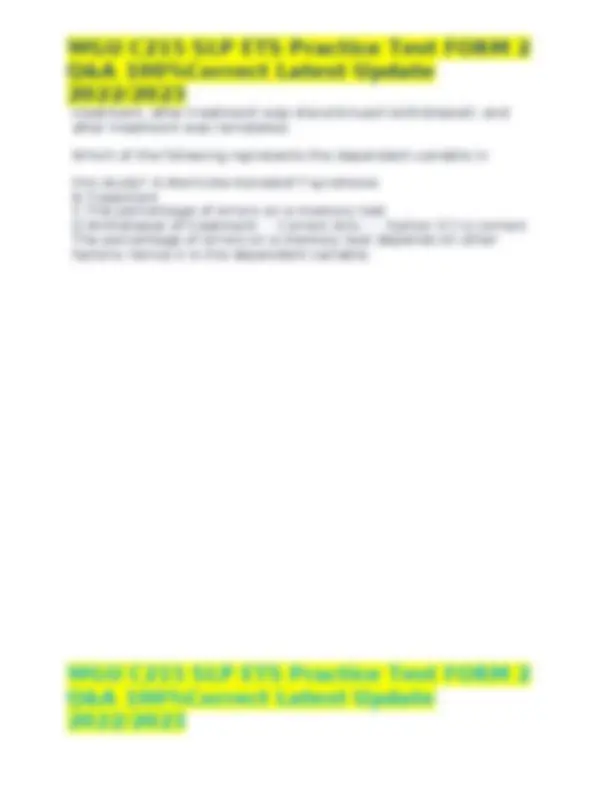
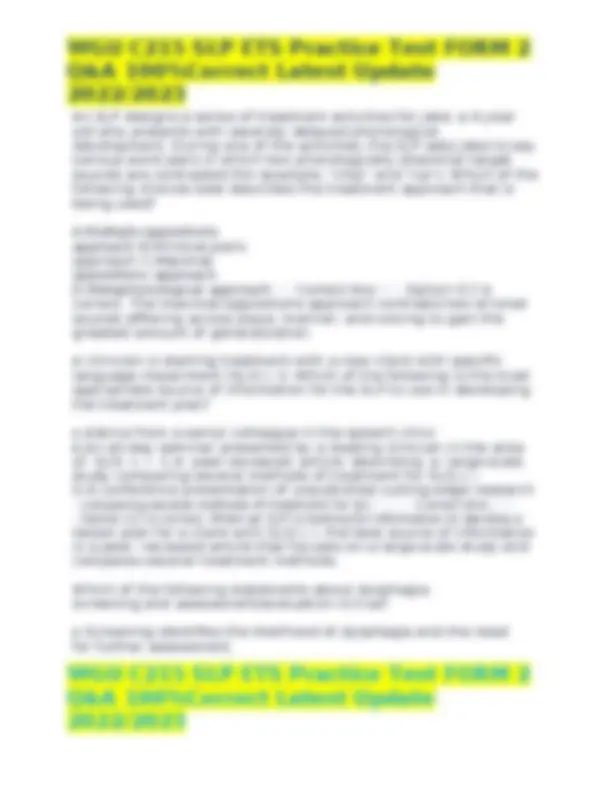
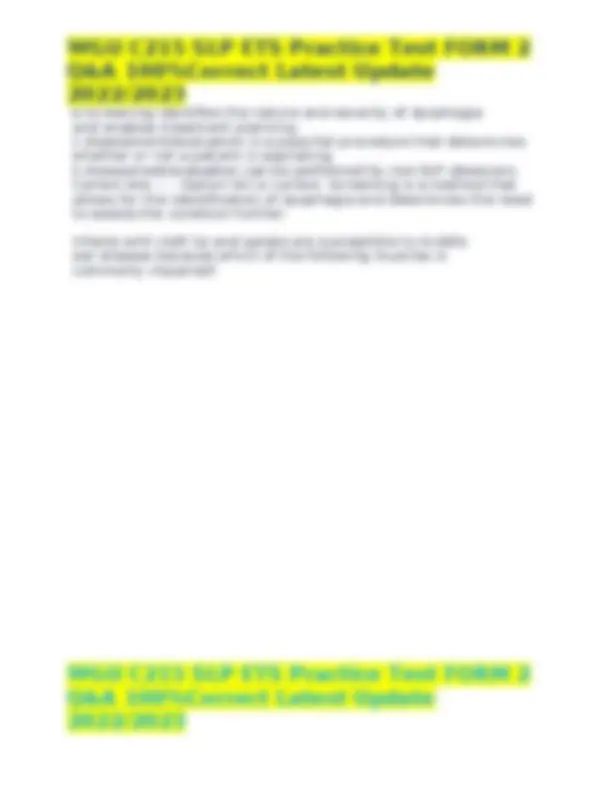
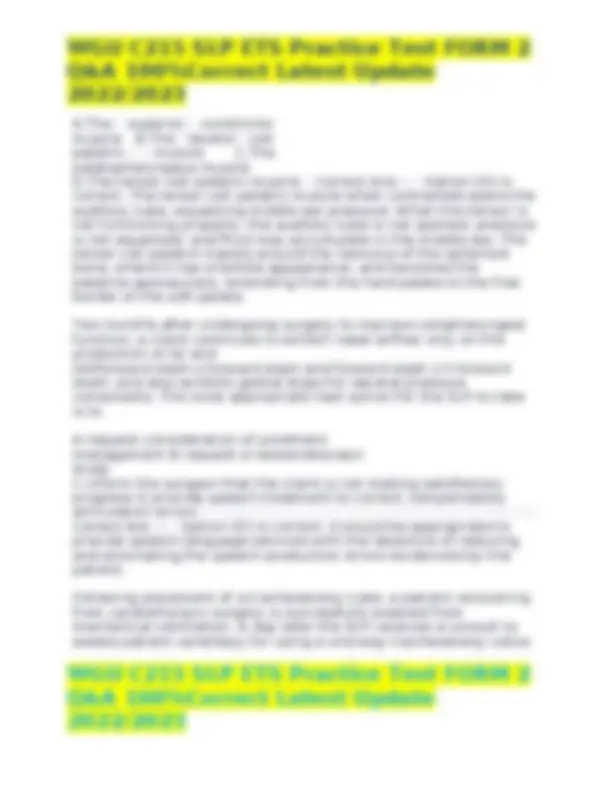
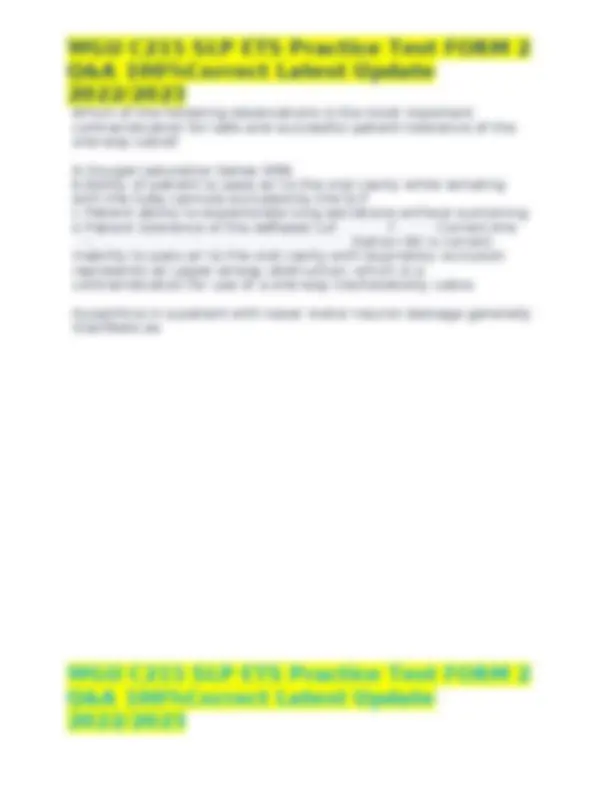
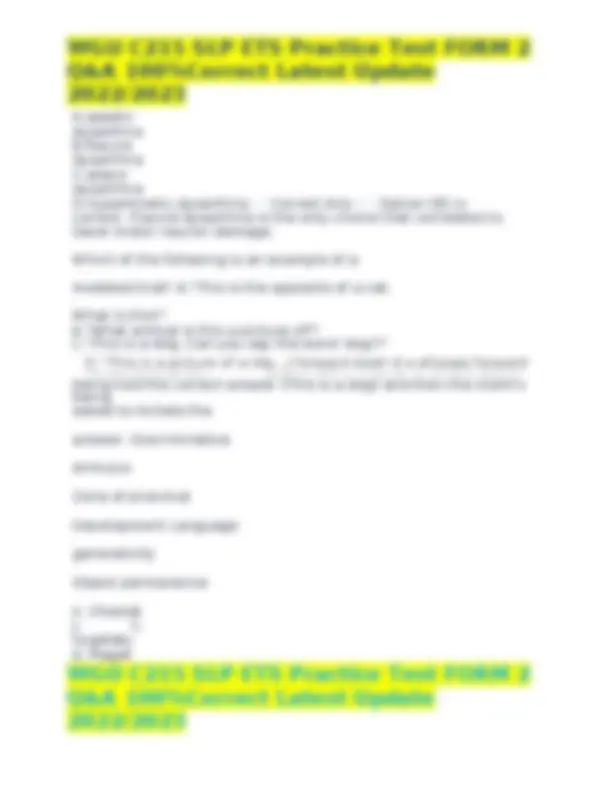
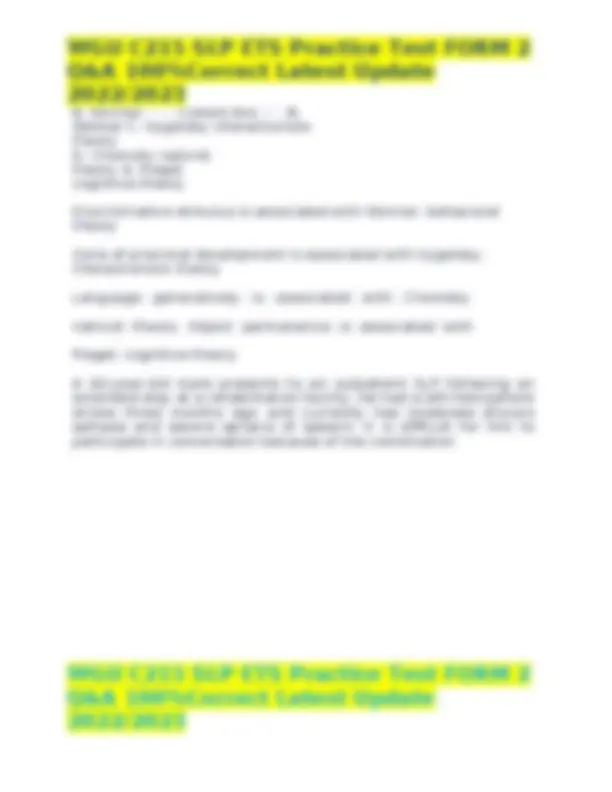
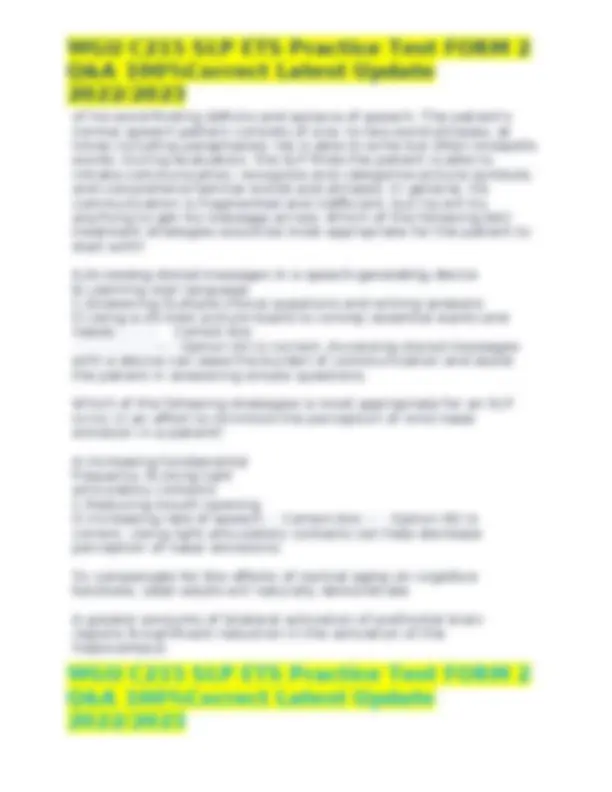
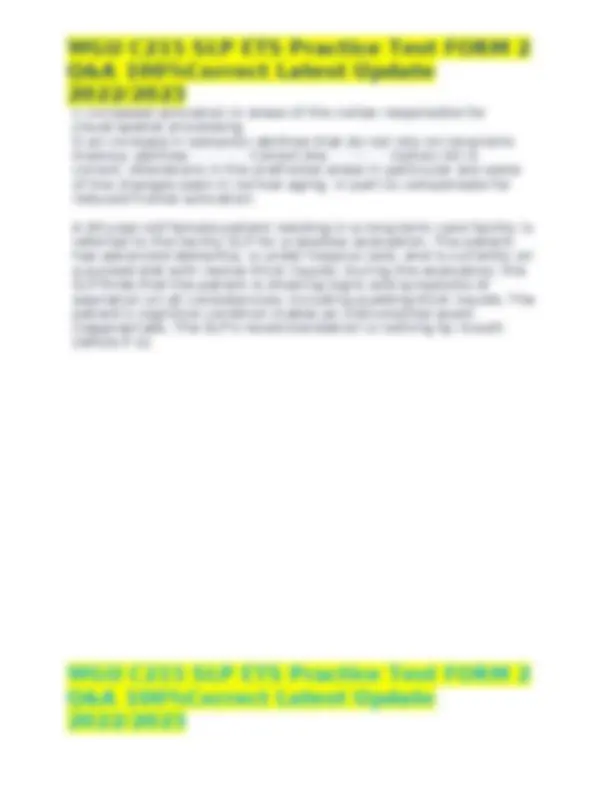
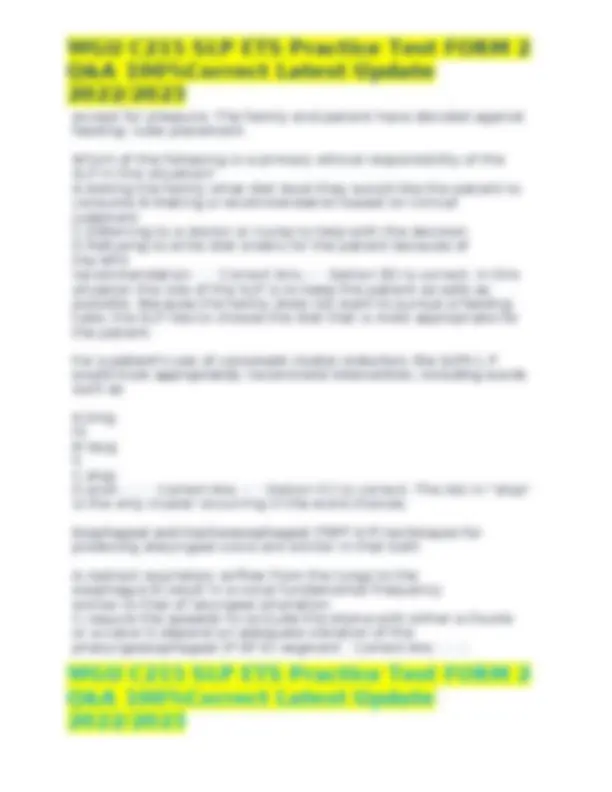
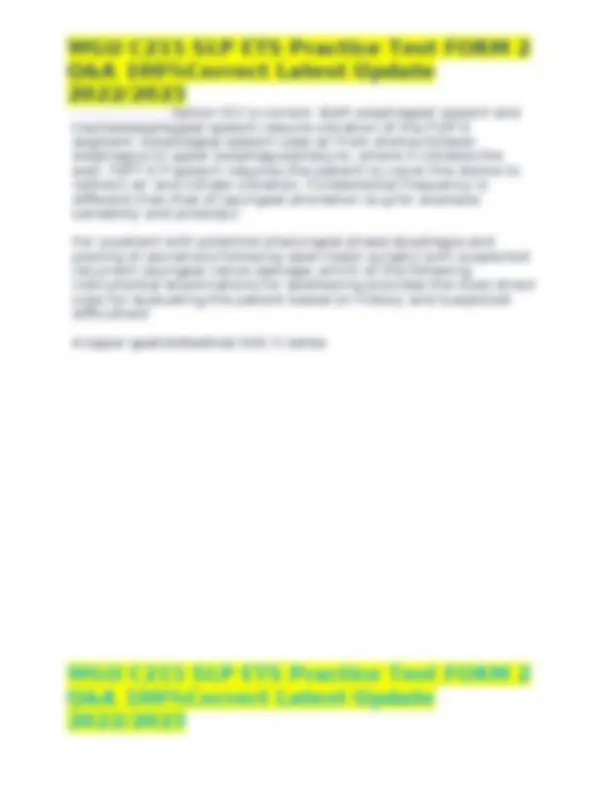
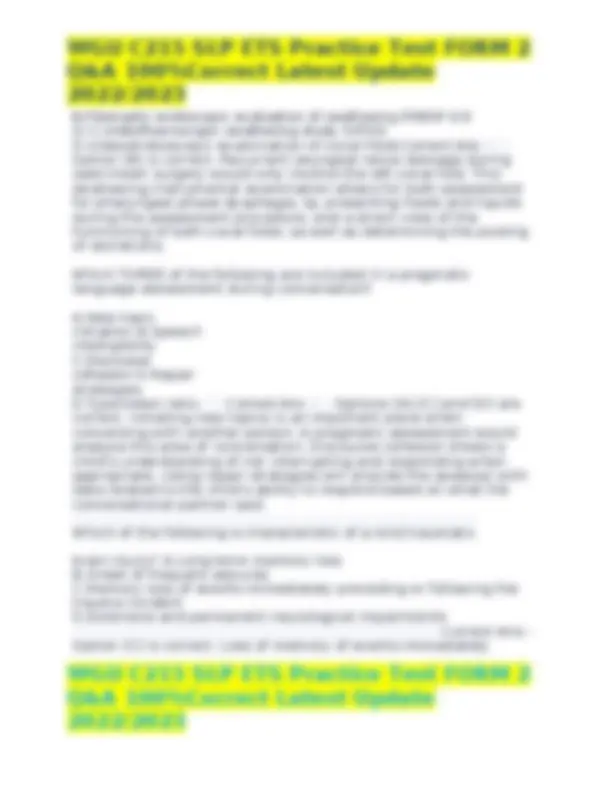
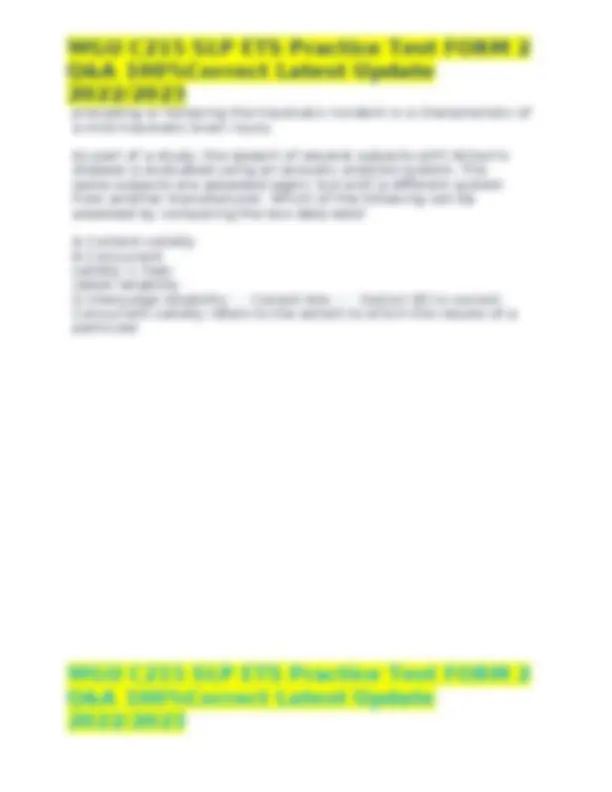
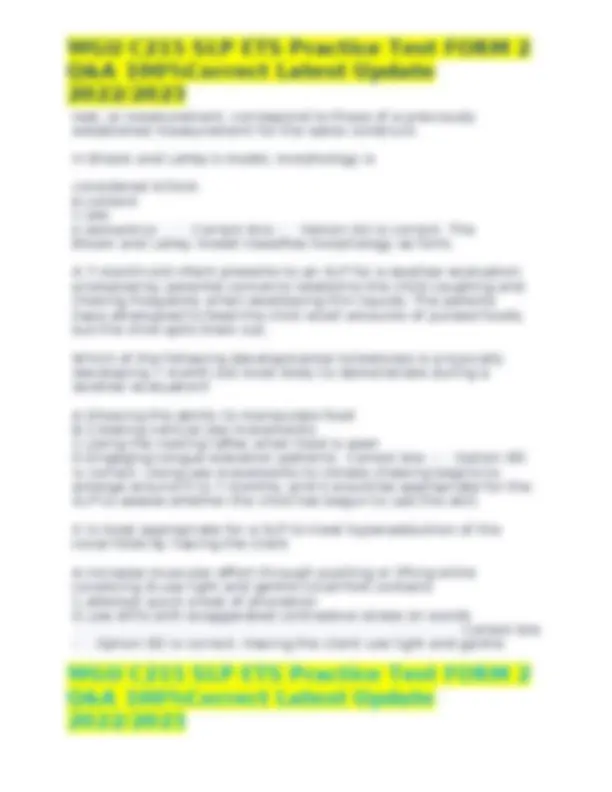
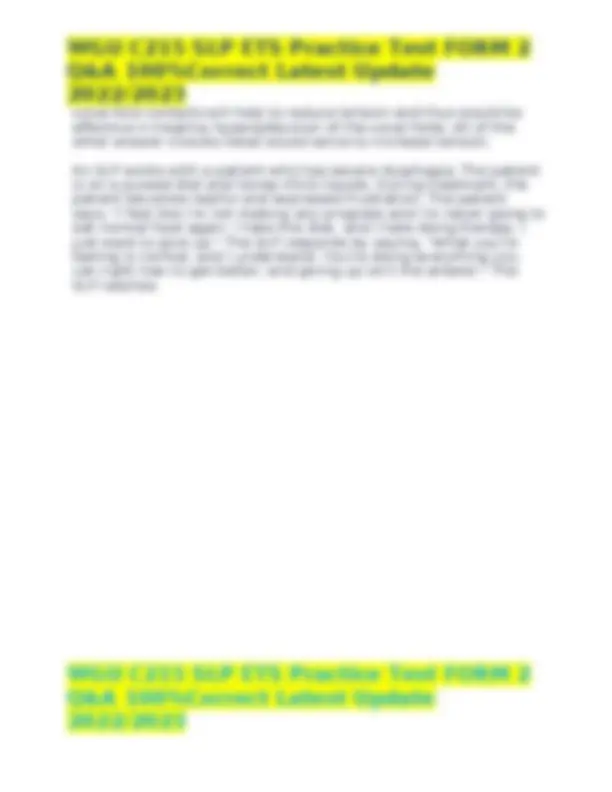
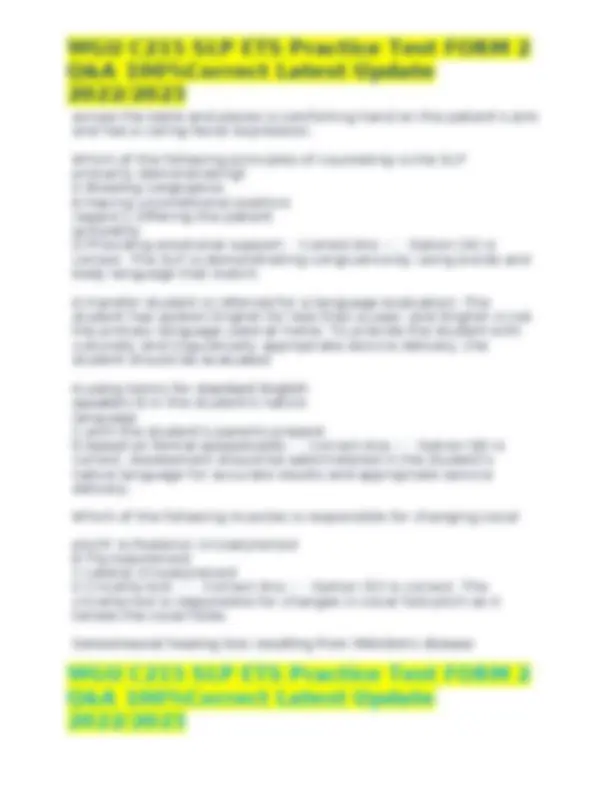
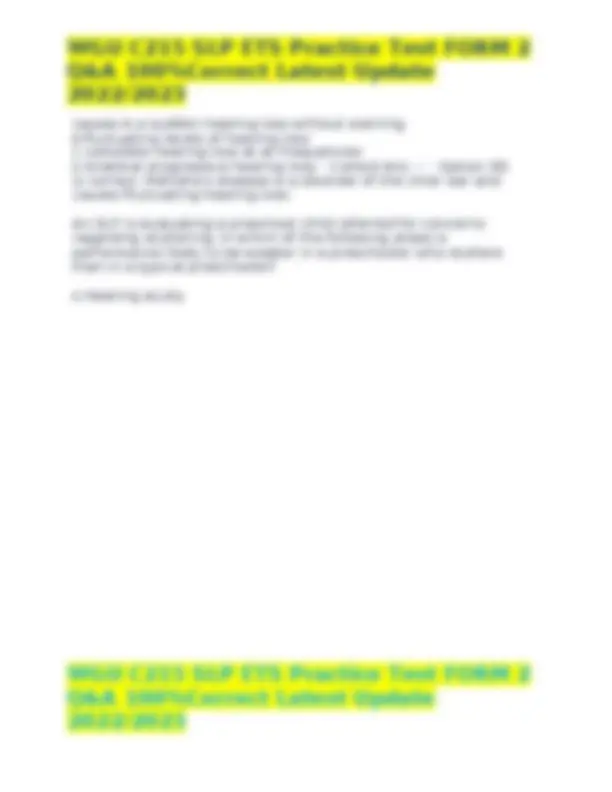
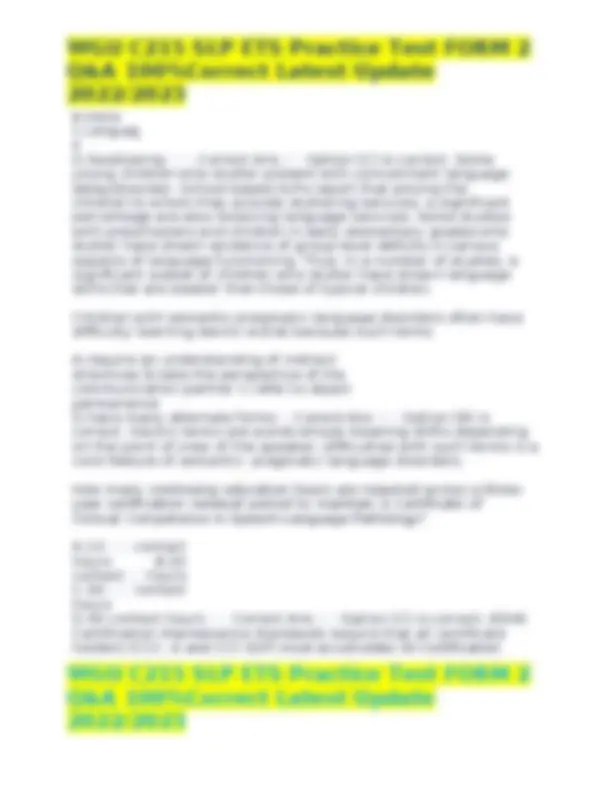
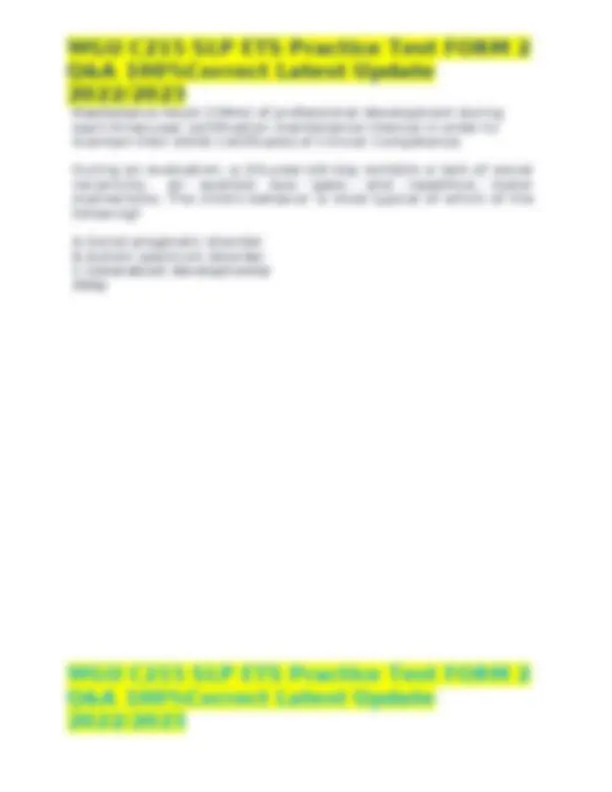
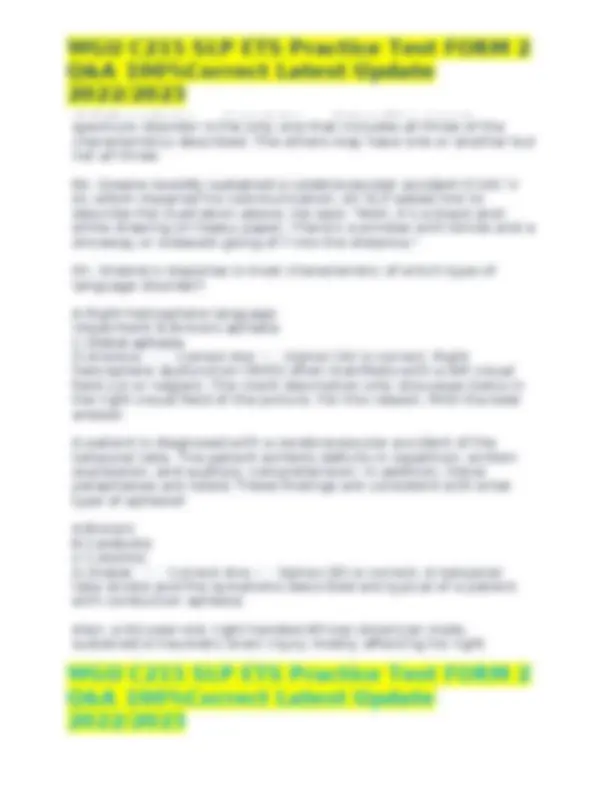
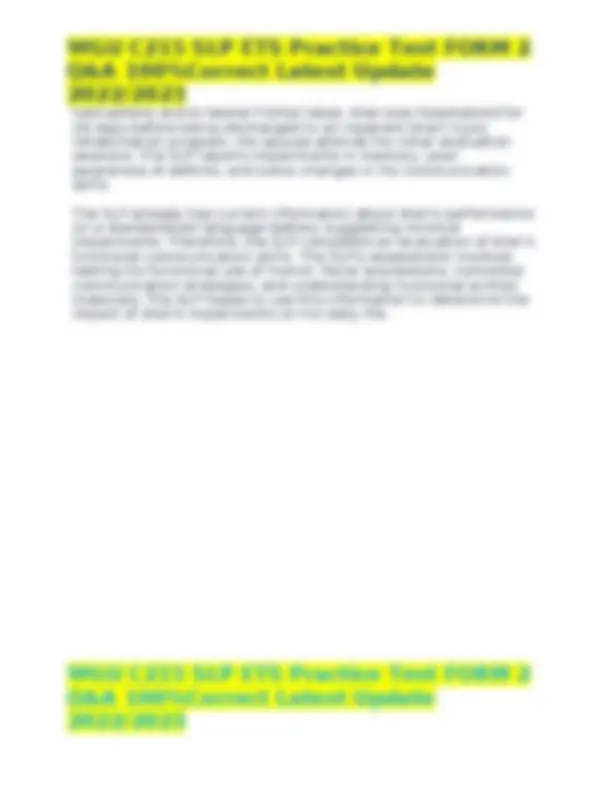
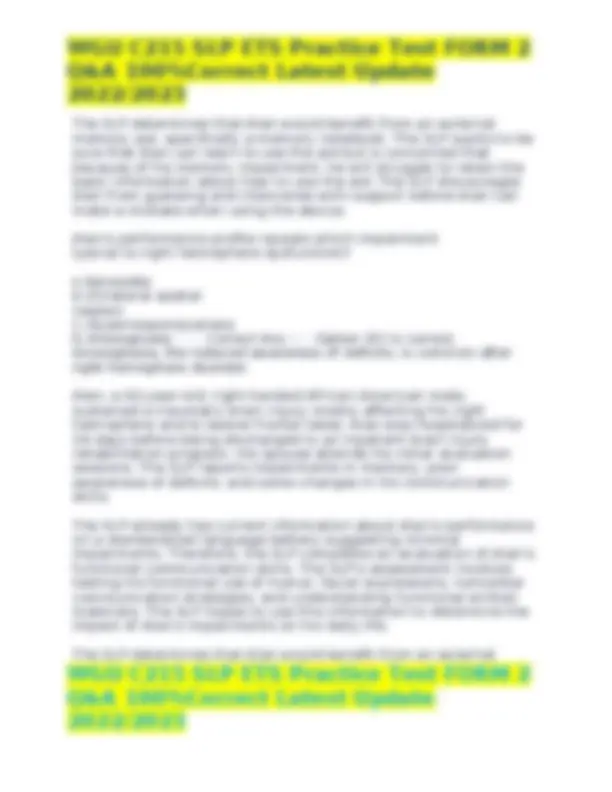
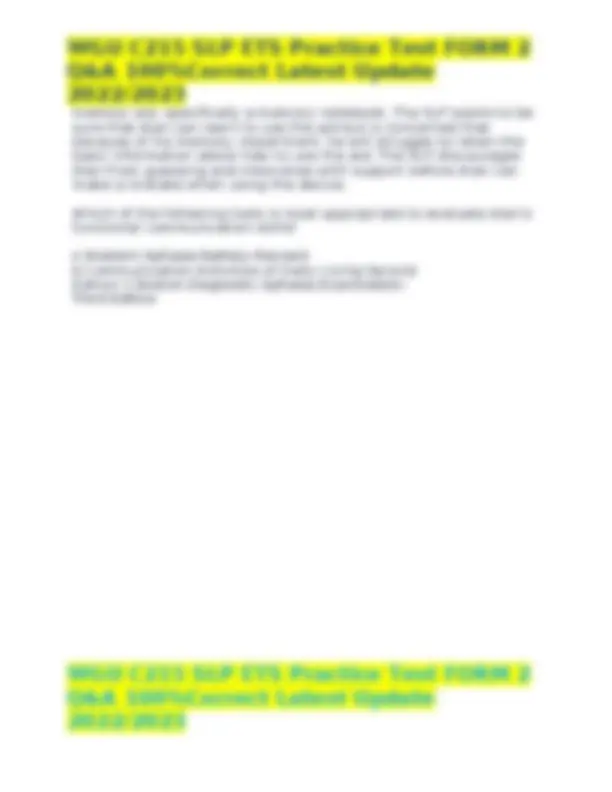
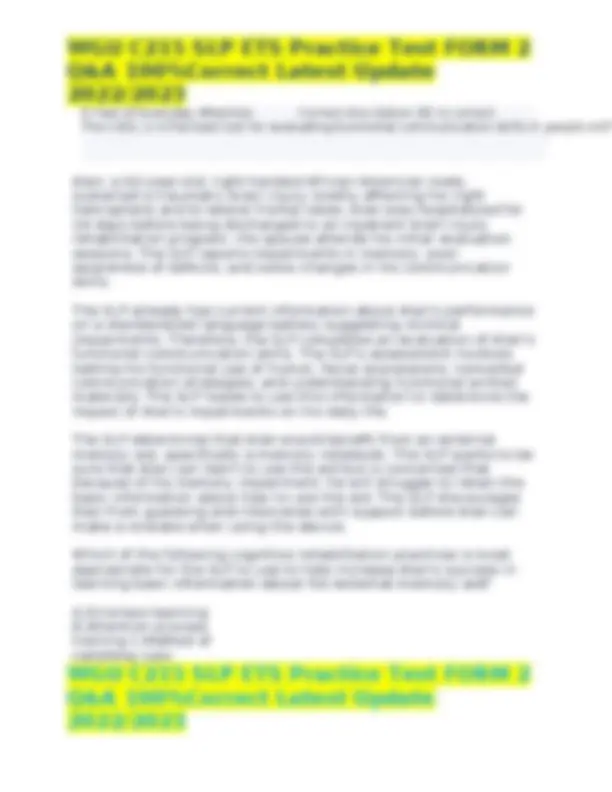
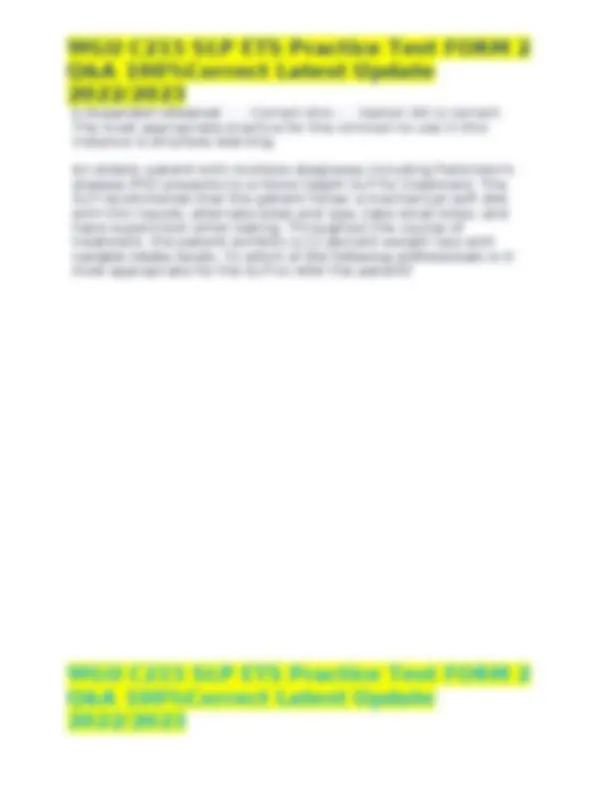
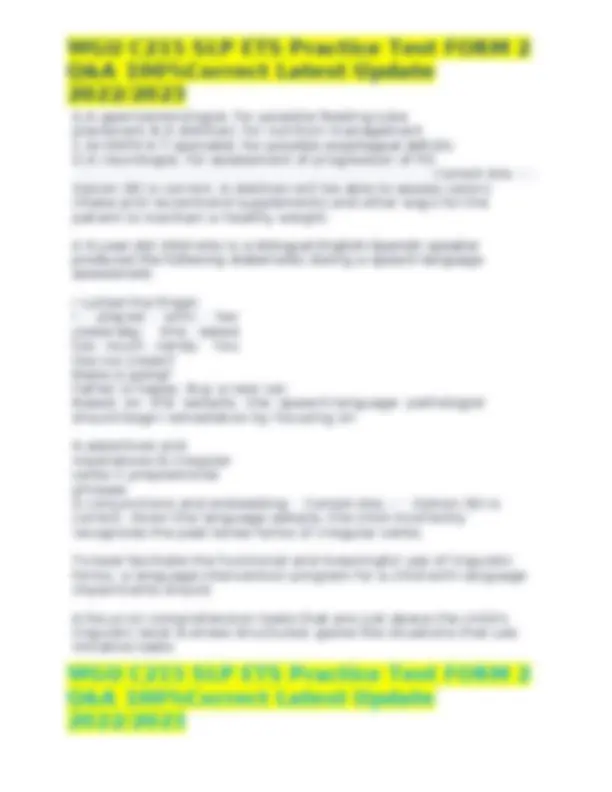
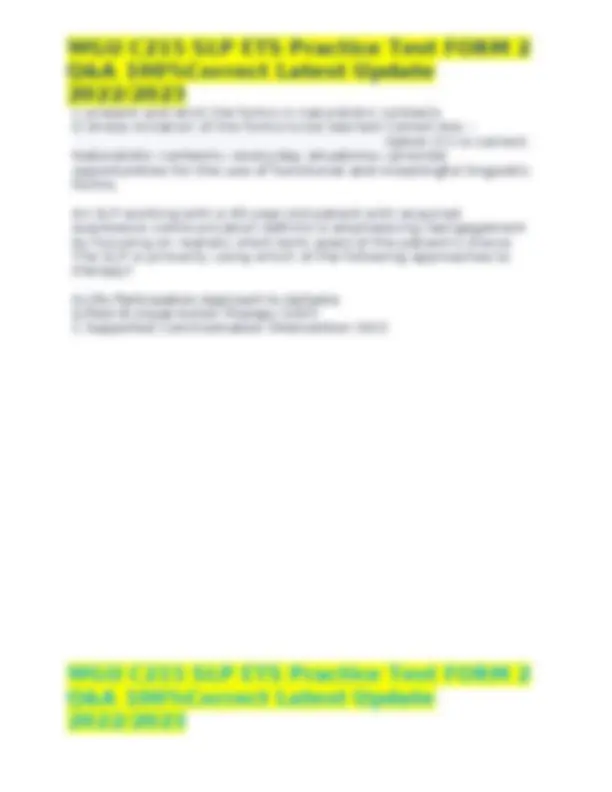

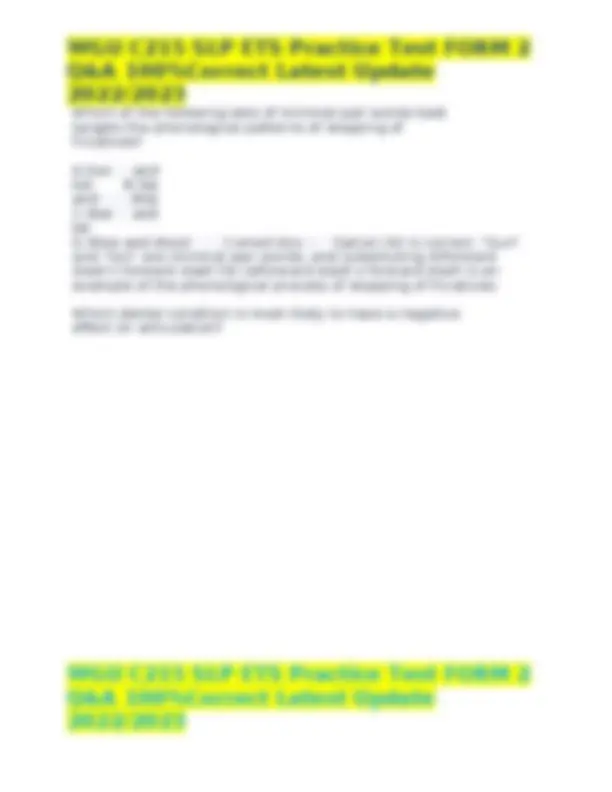
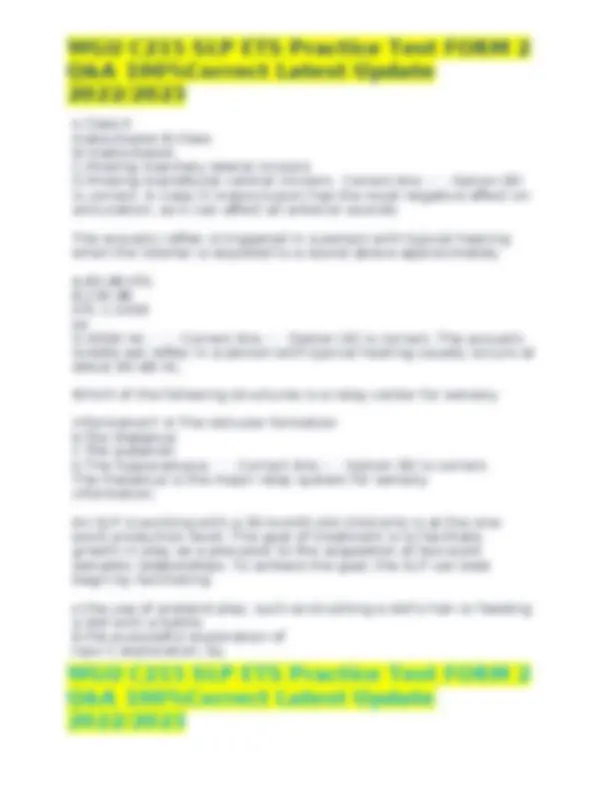
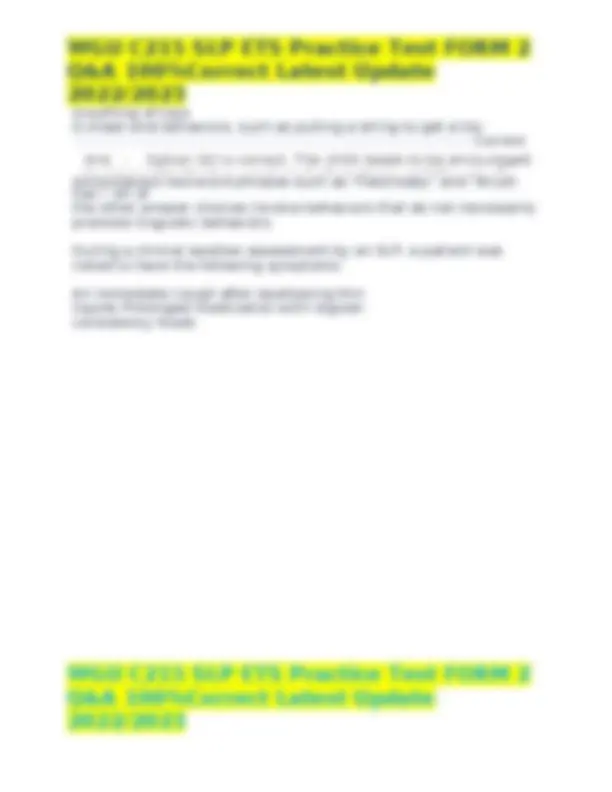
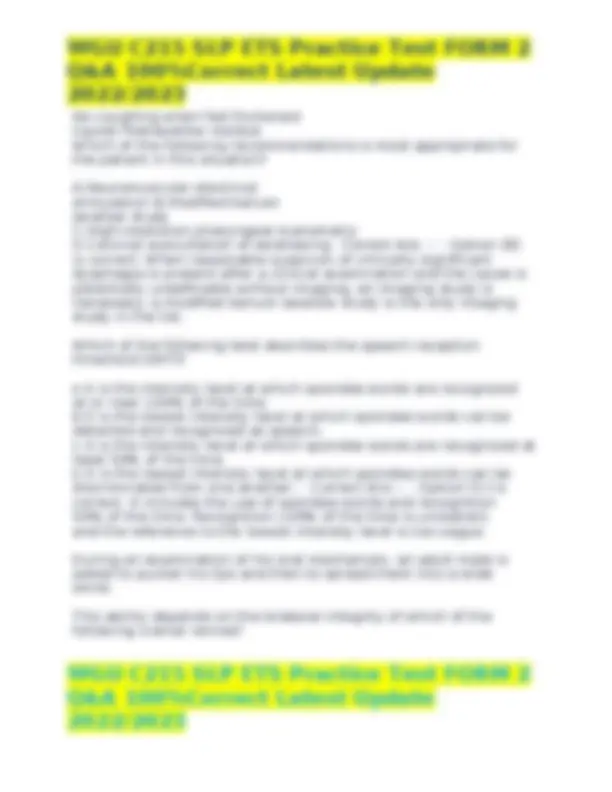
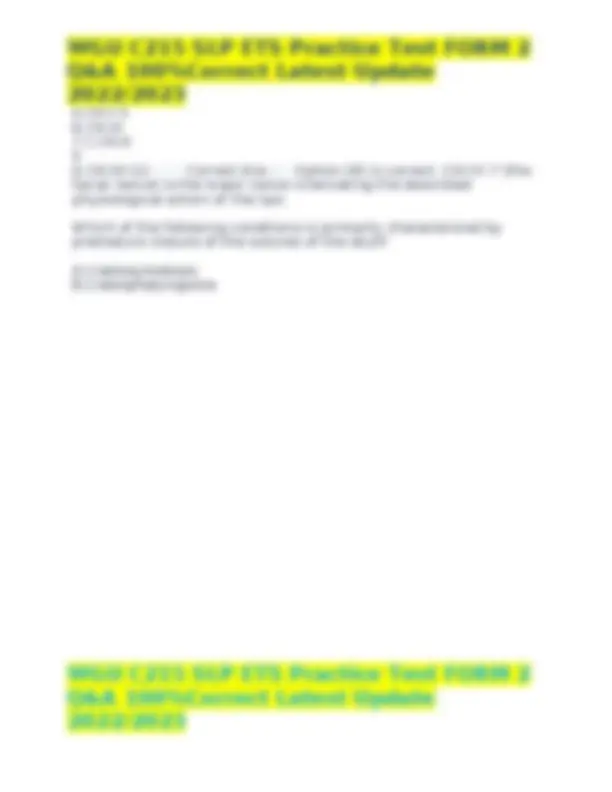
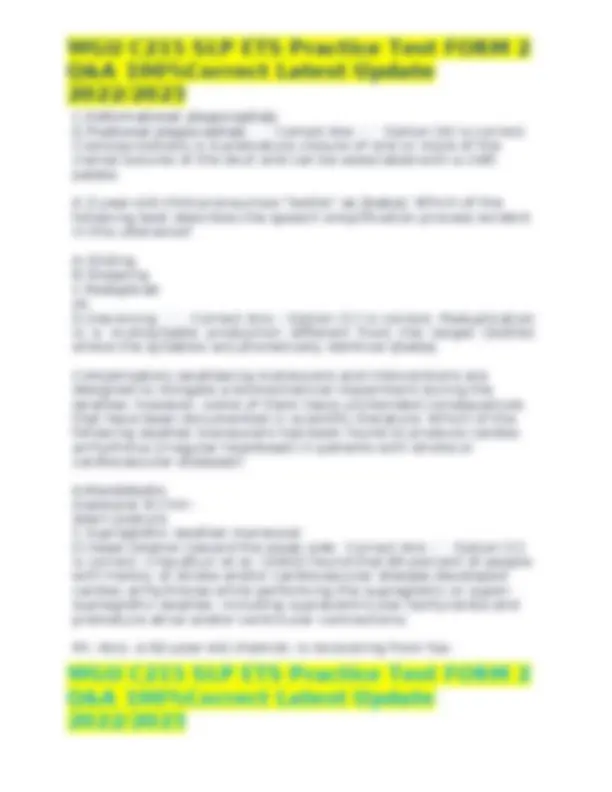
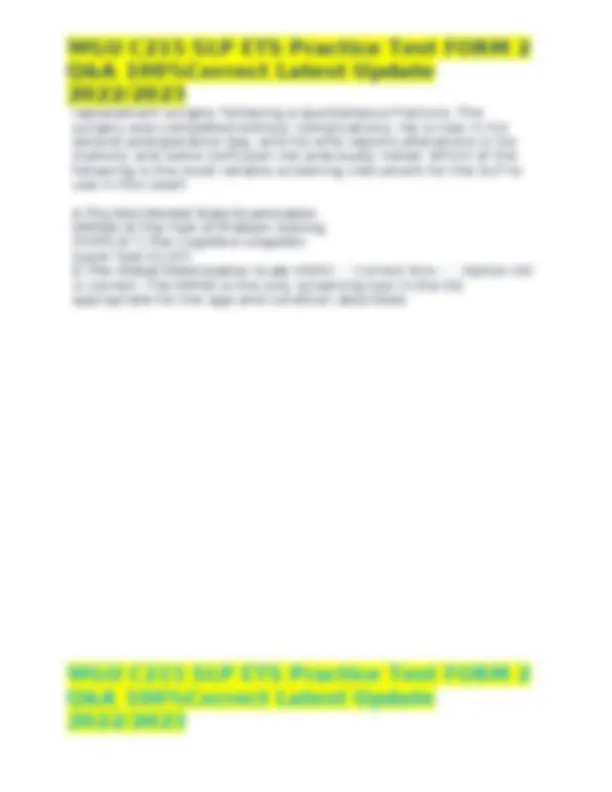
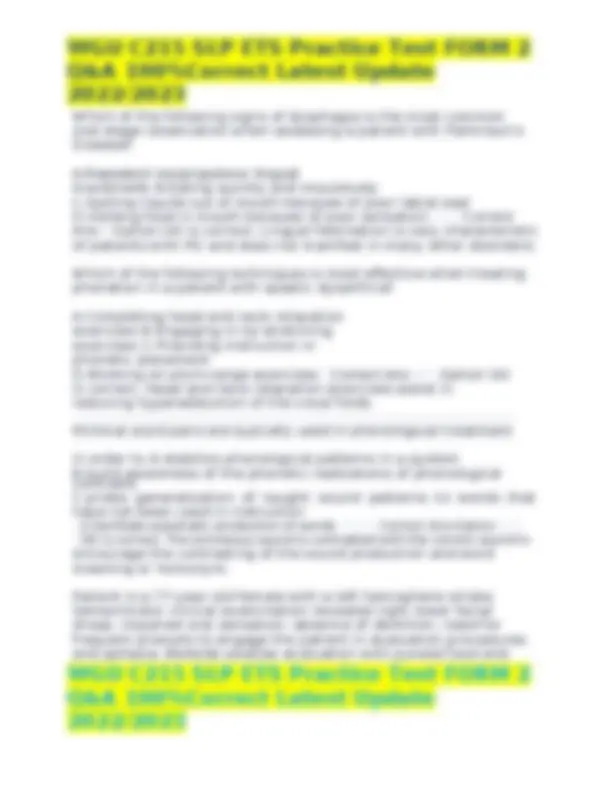
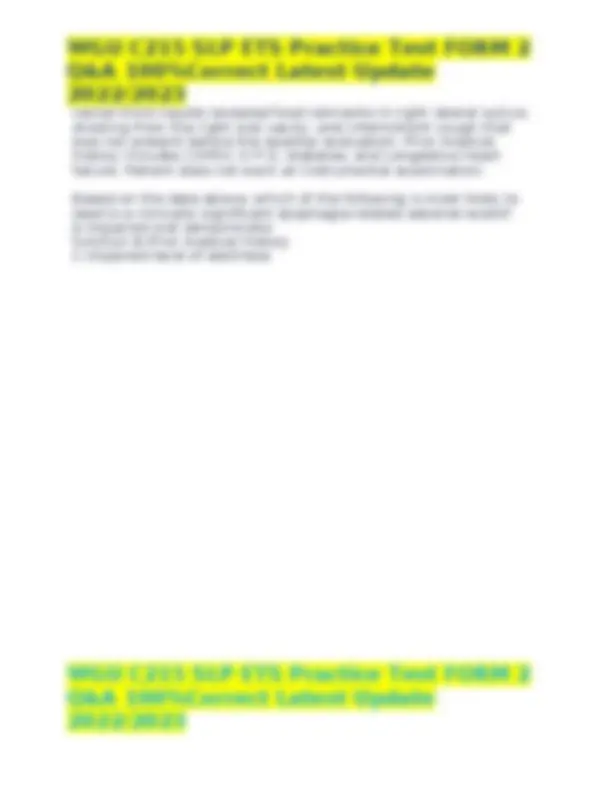
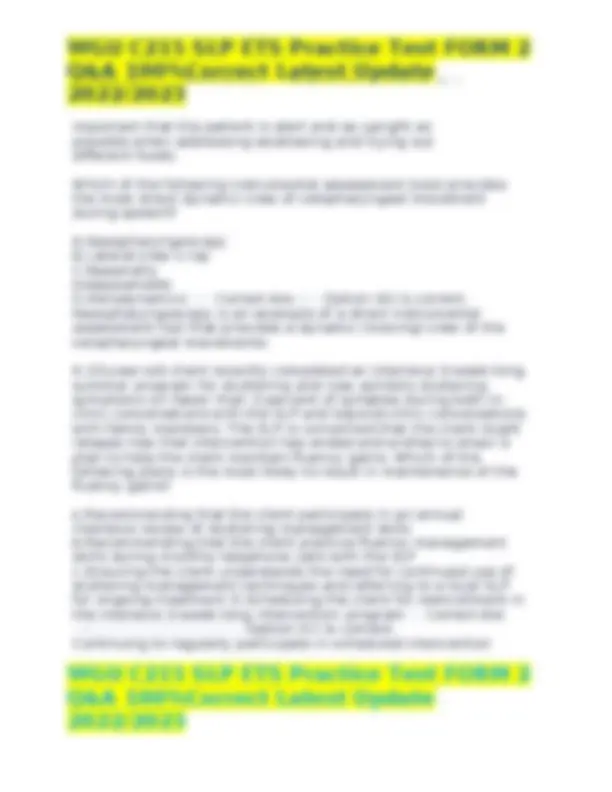
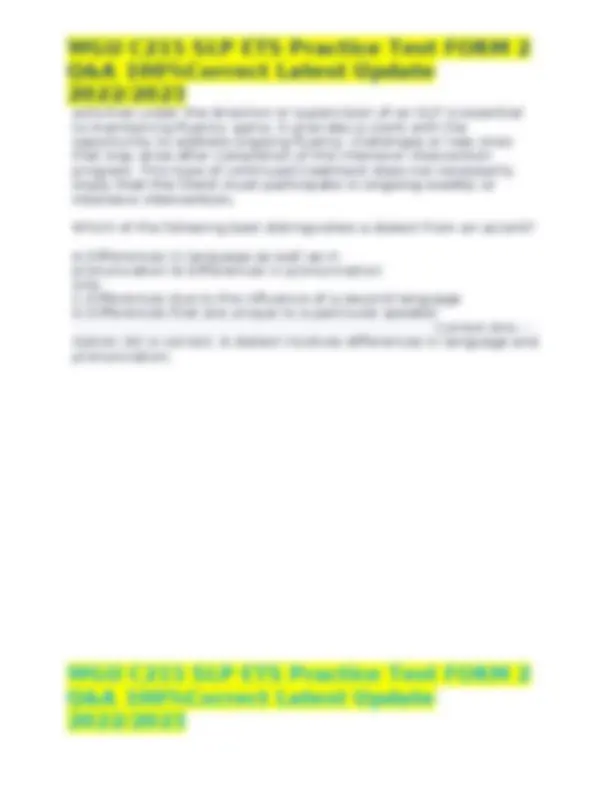
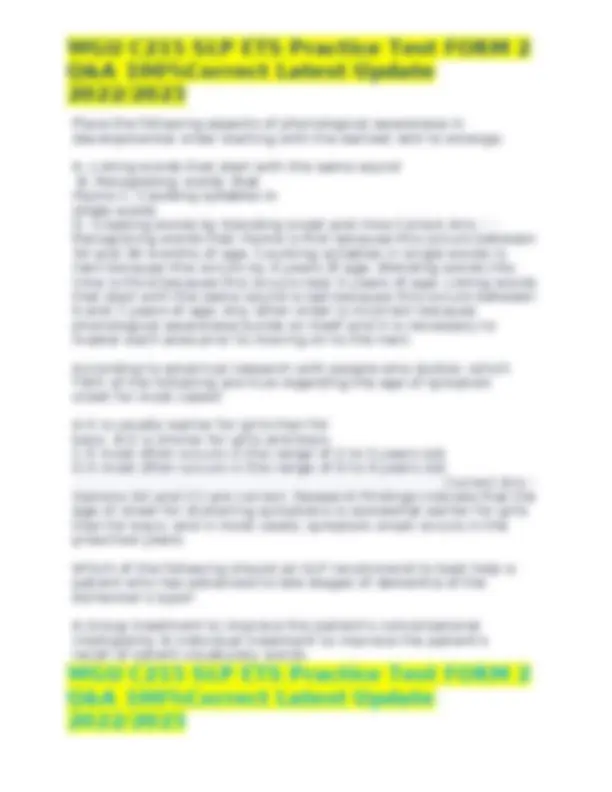
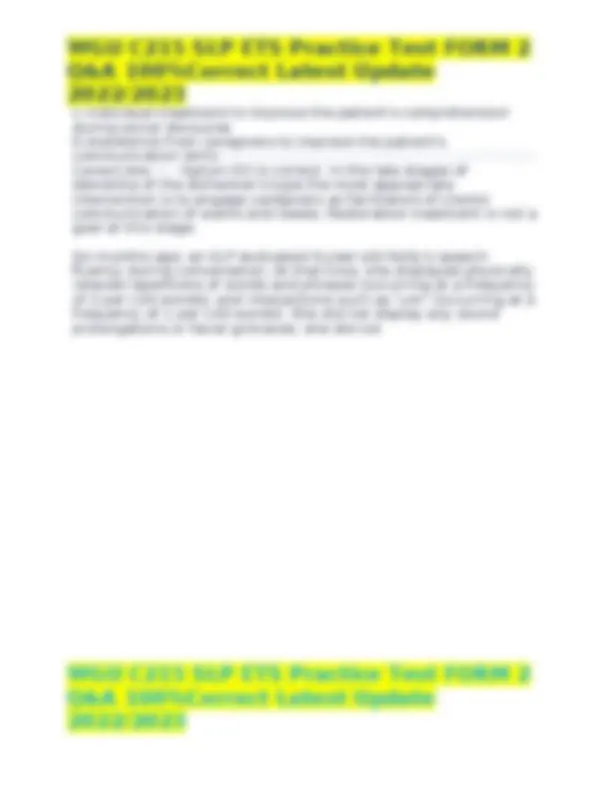
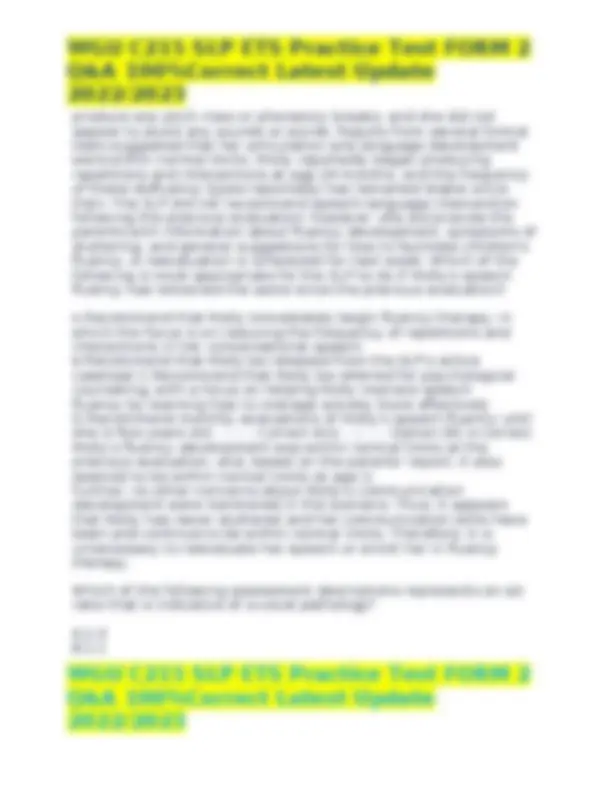
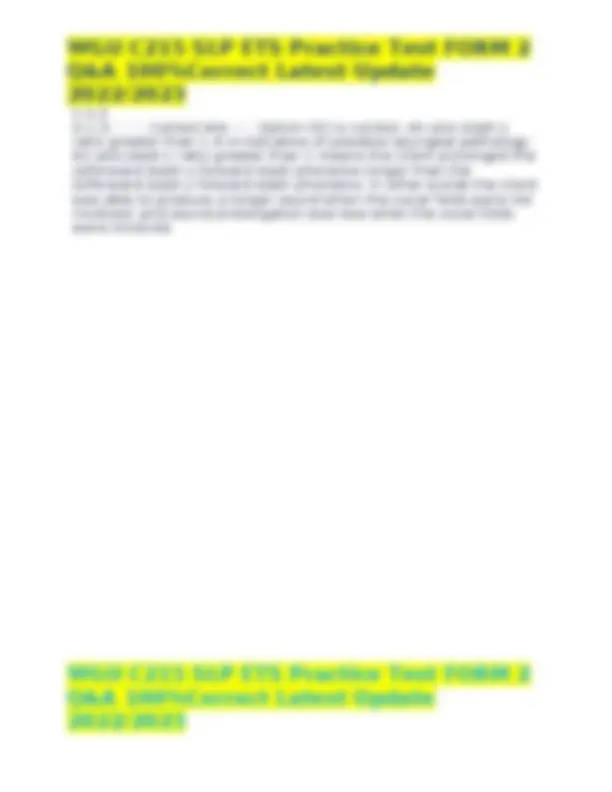
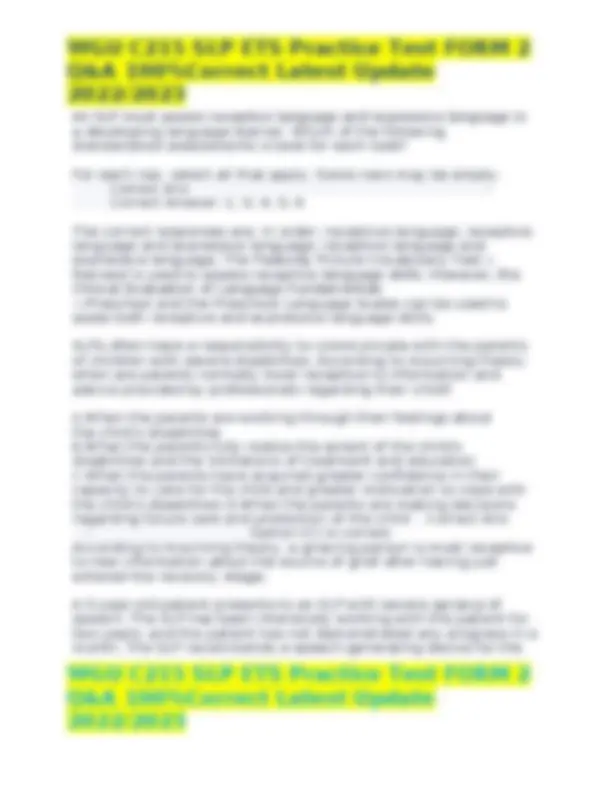
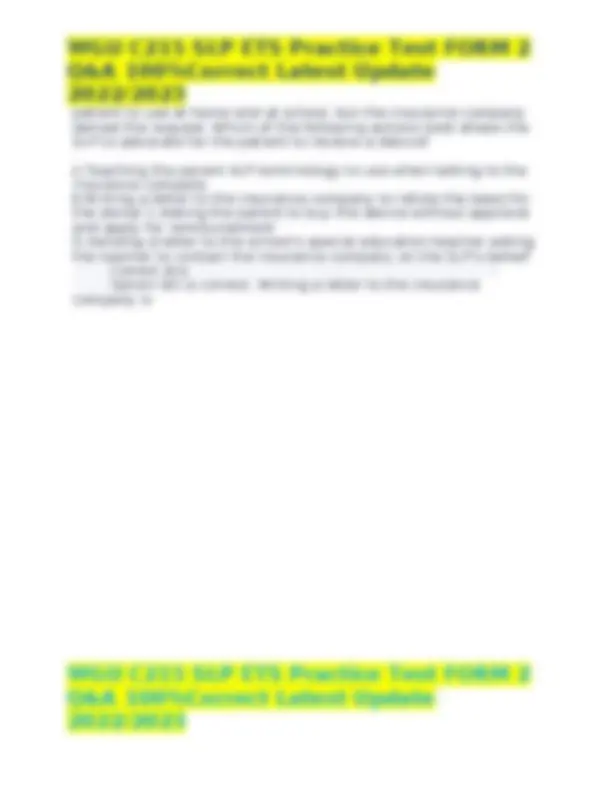
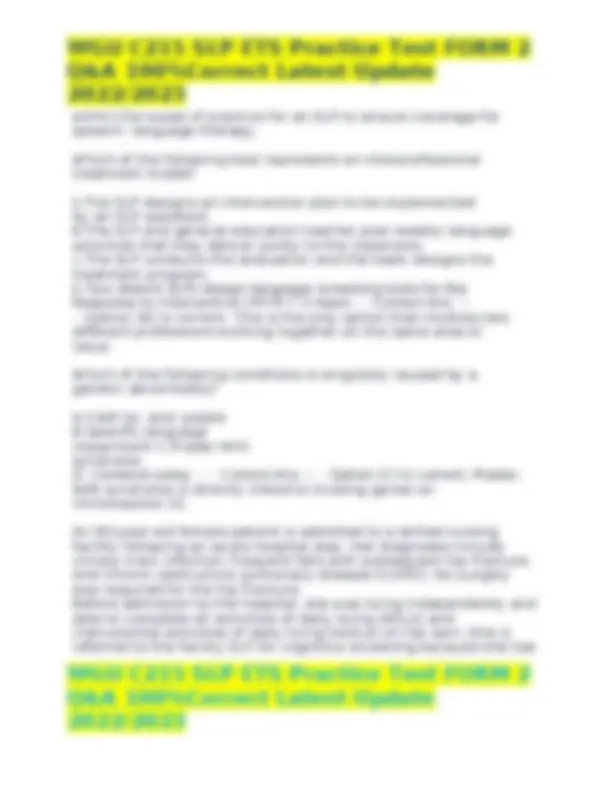
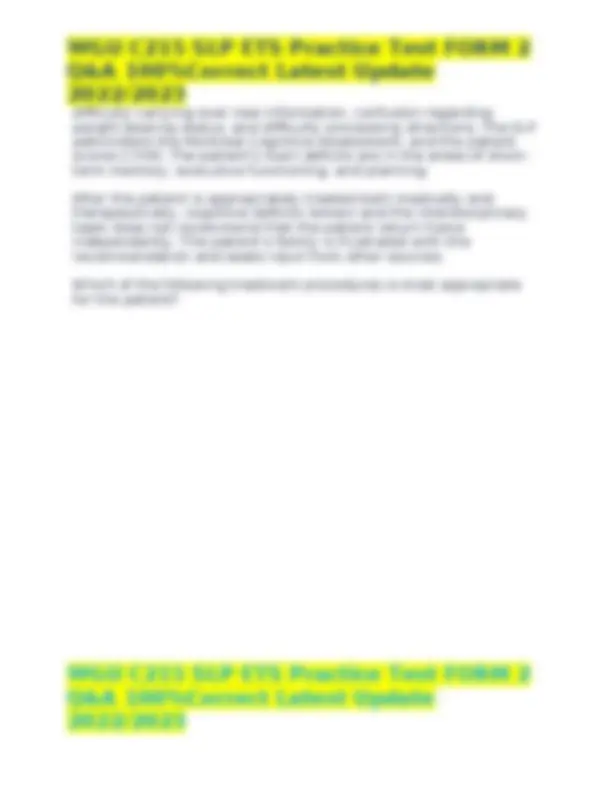
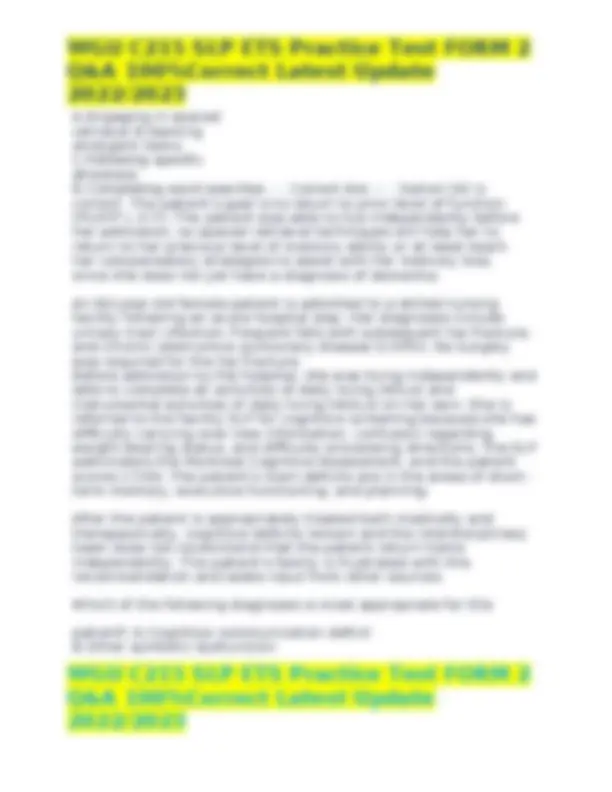
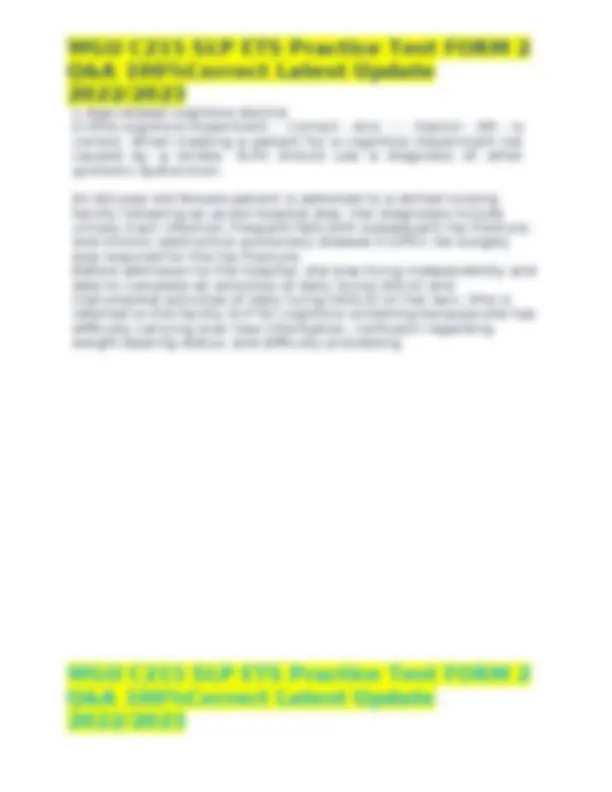
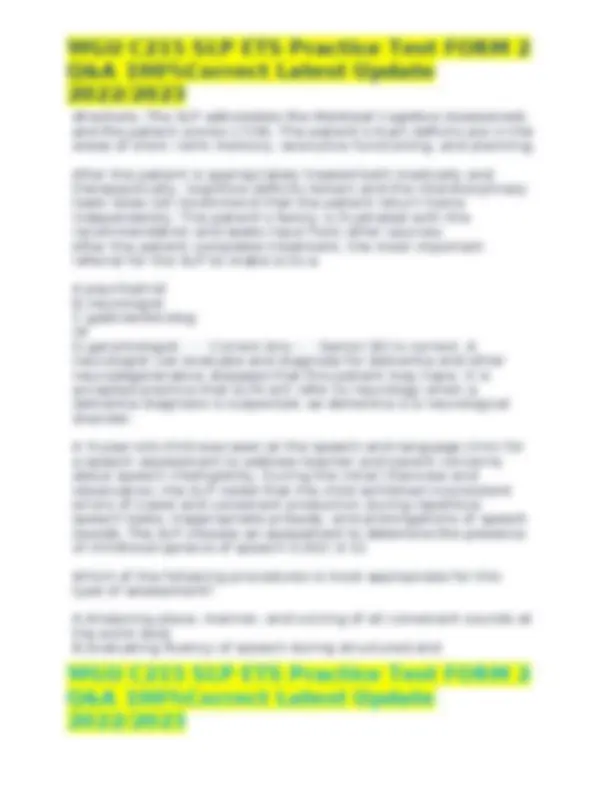
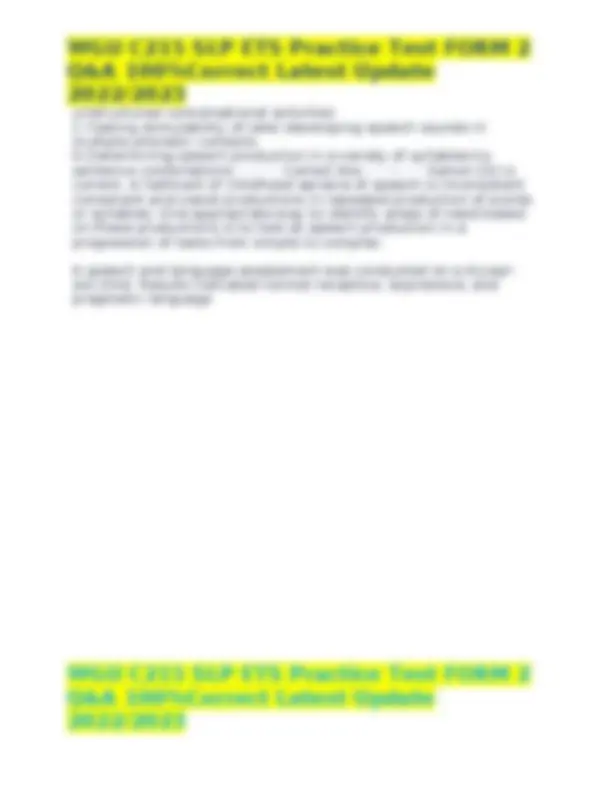
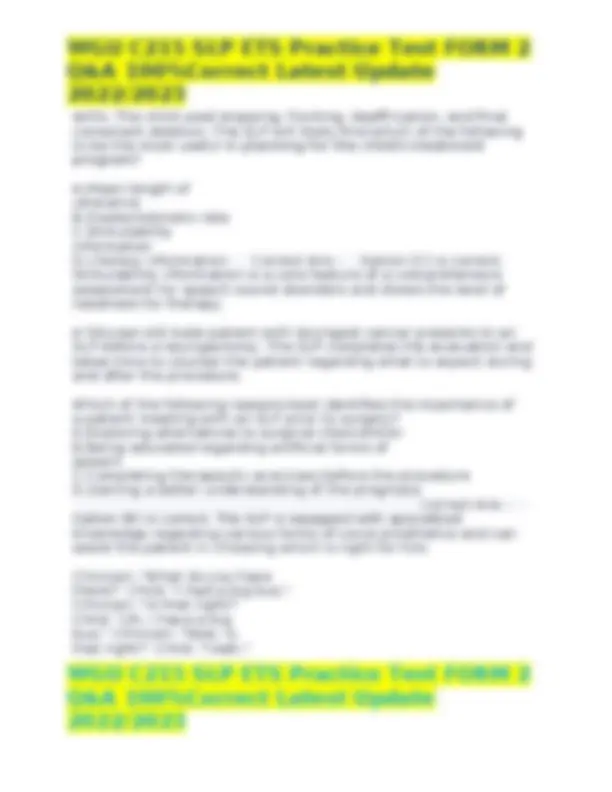
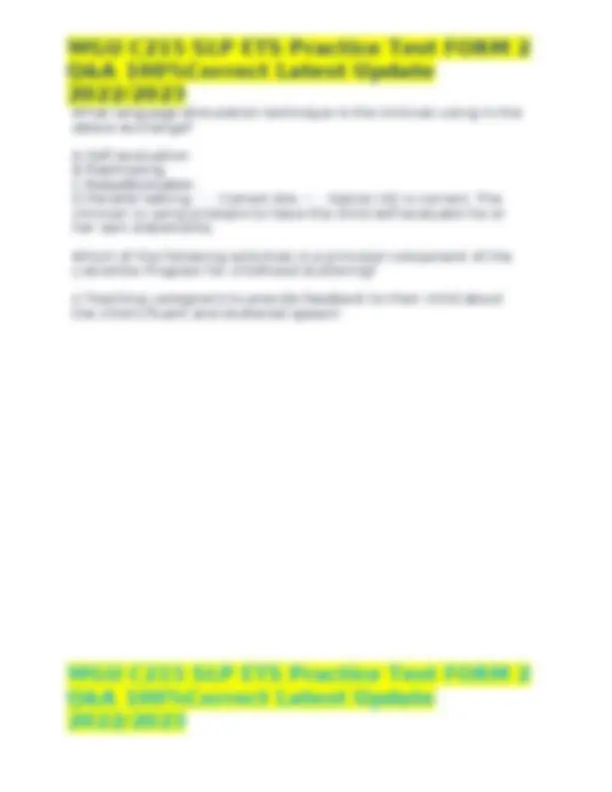
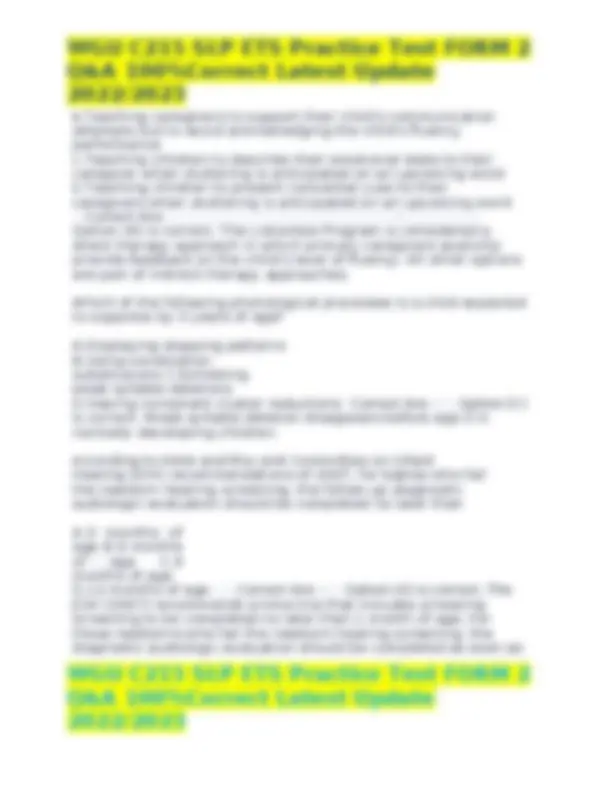
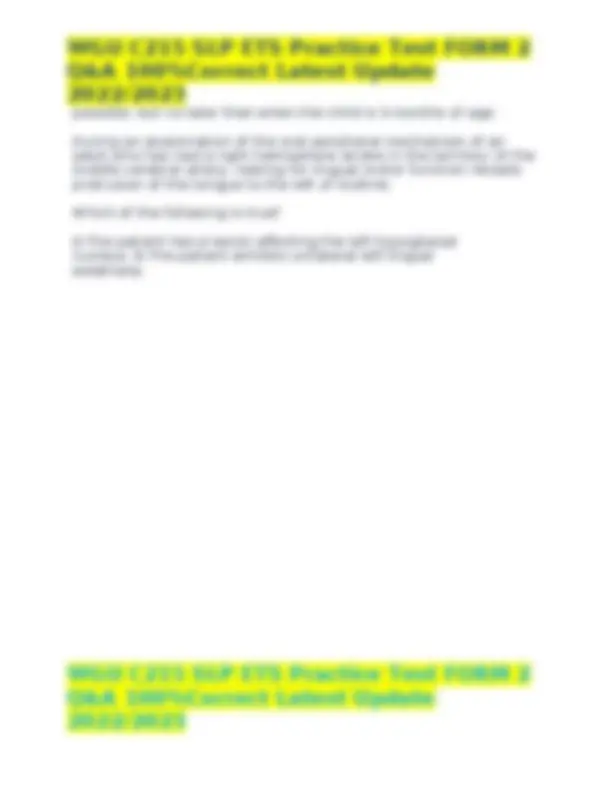
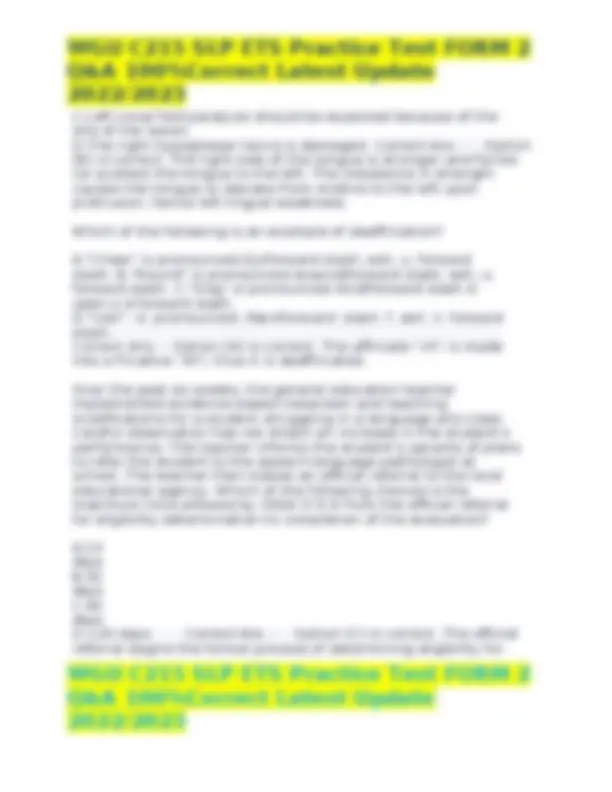
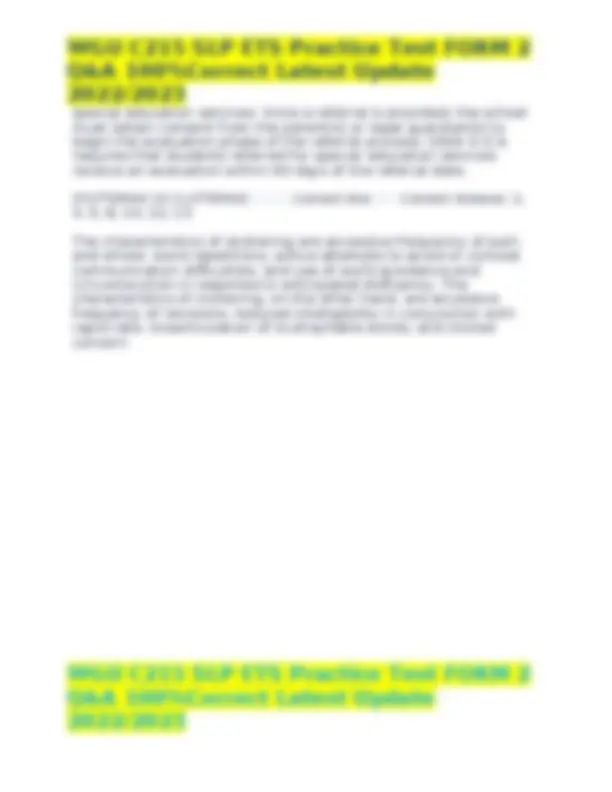
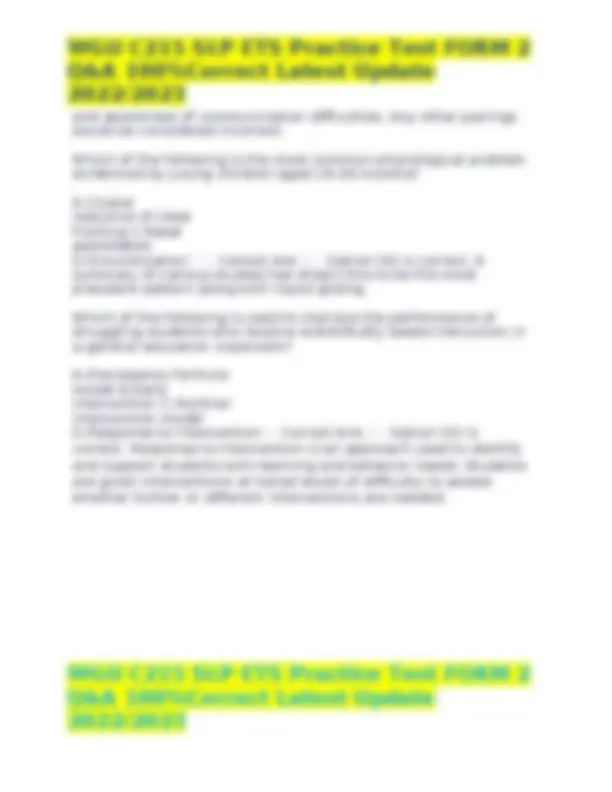


Study with the several resources on Docsity

Earn points by helping other students or get them with a premium plan


Prepare for your exams
Study with the several resources on Docsity

Earn points to download
Earn points by helping other students or get them with a premium plan
Community
Ask the community for help and clear up your study doubts
Discover the best universities in your country according to Docsity users
Free resources
Download our free guides on studying techniques, anxiety management strategies, and thesis advice from Docsity tutors
WGU C215 SLP ETS Practice Test FORM 2 Q&A 100%Correct Latest Update 2022/2023
Typology: Exams
1 / 89

This page cannot be seen from the preview
Don't miss anything!


















































































Which of the following formants typically characterizes a high vowel? A.High-frequency second formant (F2) B. High-frequency first formant (F1) C. Low-frequency first formant (F1) D. Low-frequency second formant (F2) Correct Ans - Option (C) is correct. The F1 is inversely associated with tongue height, such that high vowels tend to have low F1 frequencies. A 65-year-old patient is transferred from another facility with a diagnosis of aphasia. The patient's symptoms, however, appear more consistent with apraxia. Which of the following tasks for the patient is most appropriate when assessing verbal apraxia of speech? A.Repeating words of increasing length B.Recalling three common items C.Performing voluntary oral movements D.Following two-step commands Correct Ans - Option (A) is correct. Inability to repeat two-syllable words is a clear indicator of apraxia of speech. Oropharyngeal dysphagia in a child with Down syndrome is most likely caused by which of the following factors? A.Hypotonia B.Digestive problems C.Pneumonia D.Aversive feeding behaviors Correct Ans - Option (A) is correct. Hypotonia is the leading cause of swallowing disorders in children with Down syndrome. Which of the following recommendations to a parent of an infant with cleft lip and palate should an SLP make to best optimize
feeding for adequate nutrition and appropriate growth? A.Providing a bottle rather than breast-feeding the infant B.Positioning the infant in a supine position during feeding times C.Allowing the infant to take as much time as needed to feed D.Using a bottle with a modified nipple during feedings Correct Ans
A school-based SLP wants to discharge a fifth-grade student. The student has mastered all his goals except /r/forward slash r forward slash in conversational speech. The SLP worked with the student for the entire school year, and the student is able to use /r/forward slash r forward slash accurately 75 percent of the time. However, the goal is to reach 90 percent accuracy. Because the student worked on the skill all year and still has not met the established goal, the SLP feels the student performs at his highest possible level. The SLP does not think it is in the student's best interest to continue pulling the student out of class to address the goal. The parents are upset and are questioning the SLP's decision.
Which of the following statements from the American Speech- Language- Hearing Association (ASHA) Code of Ethics can be used to back up the SLP's decision? A. Individuals who hold the Certificate of Clinical Competence shall evaluate the effectiveness of services provided, technology employed, and products dispensed, and they shall provide services or dispense products only when benefit can reasonably be expected. B. Individuals shall honor their responsibility to hold paramount the welfare of persons they serve professionally or who are participants in research and scholarly activities, and they shall treat animals involved in research in a humane manner. C. Individuals shall use every resource, including referral and/or interprofessional collaboration when appropriate, to ensure that quality service is provided. D. Individuals shall provide all clinical services and scientific activities competently. Correct Ans - Option (A) is correct. According to ASHA, it is important that SLPs remember to provide services when a benefit can be expected. The SLP has exhausted all treatment options and a benefit for this student is no longer expected. Place the phonemes below in the order of typical acquisition. /p/ /θ/ /k/ /ʒ/ Correct Ans - /p/ /k/ /θ/ /ʒ/ /p/ is first because this phoneme is developed between ages 1 and
Which of the following medical conditions, in combination with her stroke, is likely to have the greatest impact on the patient's communication abilities? A.Seizure disorder B.Diabetes C.TBIT B I D.Obesity Correct Ans - Option (C) is correct. Patients with TBIT B I are more likely to have metacognitive problems in addition to the aphasia, thus impacting their ability to improve. An 81-year-old female presents to a rehabilitation hospital following a severe L MCA stroke. The patient has poststroke right- sided weakness, right neglect, and suspected nonfluent aphasia. Receptive language appears to be mildly impacted. The patient has a complex medical history, including TBI following a car accident two years ago, obesity, diabetes, seizure disorder, congestive heart failure, and hypertension. Socially, the patient has lived alone for the past three years following her husband's death. Since her car accident she mainly watches TV at home and leaves her house only for dialysis. She has meals on wheels and home health aides to assist her with showering. Because of her TBI, her behavior is often variable and erratic. The highest level of education she attained was seventh grade. She stayed home to take care of her children and did not have a career. Which of the following tasks is most appropriate to include when assessing the patient's phrase length? A.Completing divergent naming tasks B.Maintaining a conversation with a known partner C.Responding to open-ended questions D.Repeating sentences of varying lengths Correct Ans - Option (C) is correct. When an SLP assesses phrase length, it is important to task the patient with open-ended questions to assess the
patient's ability to spontaneously produce speech. An 81-year-old female presents to a rehabilitation hospital following a severe L MCA stroke. The patient has poststroke right- sided weakness, right neglect, and suspected nonfluent aphasia. Receptive language appears to be mildly impacted. The patient has a complex medical history, including TBI following a car accident two years ago, obesity, diabetes, seizure disorder, congestive heart failure, and hypertension. Socially, the patient has lived alone for the past three years following her husband's death. Since her car accident she mainly watches TV at home and leaves her house only for dialysis. She has meals on wheels and home health aides to assist her with showering. Because of her TBI, her behavior is often variable and erratic. The highest level of education she attained was seventh grade. She stayed home to take care of her children and did not have a career.
An SLP provides home practice for a patient with aphasia as part of discharge plans. The patient is approximately six-months post left- hemisphere stroke that resulted in aphasia. Verbal output has improved significantly since the stroke; however, the patient is still very concerned that written expression is moderately impaired at the single-word level. The homework assignment is to implement copy-and-recall treatment to improve written expression, which involves practicing writing target words (from photographs) and then copying those words multiple times. However, during a follow-up phone call, the SLP determines that the patient is struggling to write the assigned target words because the patient "can't think of the correct letters." Although a model is provided on the back of each target photograph, the patient wants to find a way to practice without looking at the answer. The SLP's best course of action is to suggest that the patient
A.try anagramming the words using letter tiles to form the target word B.practice writing the alphabet in order multiple times before beginning the homework again C.use a cell phone voice-to-text application as a compensatory strategy D.use drawing to convey messages instead of using written expression Correct Ans - Option (A) is correct. This approach would give the client the best access to completing the homework. The letter tiles would provide a support for the client to complete the homework and are a regular part of this treatment approach. Which of the following instruments is often used to document stages of recovery after traumatic brain injury (TBI)? A.Glasgow Coma Scale B.Scale of Executive Function C.Sequenced Inventory of Communication Development D.Rancho Los Amigos Scales of Cognitive Function Correct Ans - Option (D) is correct. The Rancho Los Amigos Scales of Cognitive Function is the only truly "scaled" instrument developed specifically for rehabilitation documentation following TBI. A large metropolitan school district wants to determine the prevalence of developmental stuttering among all enrolled students during the past year. Which of the following approaches is most appropriate for accomplishing the task? A.Dividing the total number of students who currently stutter by the total number of students who were enrolled during the past year B.Subtracting the total number of students who received treatment for stuttering during the past year from the total number of students who currently stutter C.Multiplying the total number of students who currently stutter by the total number of students enrolled during the past year D.Dividing the total number of newly identified students who stutter by the total number of students enrolled during the past year Correct Ans -
B. Assimilatio n C.Enculturati on D.Ethnocentrism Correct Ans - Option (A) is correct. Acculturation is the incorporation of the host culture's perspective and the native culture's perspective and values. The commonly used chin-down posture was initially developed to eliminate thin-liquid aspiration in people with delayed pharyngeal stage onset after having a stroke, and when its efficacy was investigated, it was found to be 50% effective. For whom is the chin-down posture ineffective at eliminating thin- liquid aspiration? A.People who have cricopharyngeal dysfunction B.People who aspirate residue from the pyriform sinuses C.People who have impaired lingual function D.People who aspirate residue from the valleculae Correct Ans - Option (B) is correct. Shanahan et al. (1993) found that 50 percent of people with stroke- and swallowing-related aspiration due to delayed onset of the pharyngeal response continued to aspirate from the pyriform sinuses using the chin-down posture. Moreover, Eisenhuber et al. (2002) found that people with a pyriform sinus residue with a height that was less than 50 percent of the pyriform sinus height aspirated significantly more than those with less or no pyriform sinus residue. Which of the following strategies to treat compensatory articulation errors is most appropriate for a child with hypernasality and glottal stop substitutions following surgery for velopharyngeal insufficiency? A. Using oral motor exercises B. Using a straw to elicit /s/forward slash s forward slash C.Using tactile cues to elicit
phonemes D.Using negative practice Correct Ans - Option (C) is correct. Tactile cues are used to elicit correct articulation placement. Which of the following neuroimaging studies specifies which artery or arteries is/are occluded in a patient with a stroke? A.Electroencephalograph y B.Magnetoencephalograp hy C.Evoked-response potentials D.CT or MR angiography Correct Ans - Option (D) is correct. These studies will give results which specify which artery is occluded. Which of the following statements best indicates a screening tool with high sensitivity?
observations alone will produce the best improvement in the pneumonia risk of an adult patient with chronic dysphagia? A.Poor oral bolus control and containment B.Poor oral hygiene and dependence for oral care C.Delayed onset of the pharyngeal stage of swallowing D.Impaired distension of the upper esophageal sphincter Correct Ans
presence of decayed teeth) and dependency for oral care as significant independent predictors of pneumonia in people with chronic dysphagia. Which of the following is a distinguishing characteristic of articulation therapy for a 2-year-old patient with a repaired cleft palate and compensatory errors? A.Cycling through multiple speech goals in a given session B.Having a play-based learning approach to address goals C.Focusing on carryover of speech productions D.Addressing speech targets with high frequency and intensity Correct Ans - Option (B) is correct. Based on the age of the child, the only appropriate treatment listed is a play-based approach. All other treatments listed are inappropriate for the age of the child. Early intentional communication typically emerges in the months leading up to a child's first birthday. Which of the following communicative functions typically emerges first in this period? A.Requesting B.Commenting C.Protesting D.Greeting Correct Ans - Option (C) is correct. Early intentional communication develops around 8 to 10 months of age, and the first function that emerges is protesting. An SLP plans to give Cody, an 8-year-old boy with autism spectrum disorder, tangible reinforcement in conjunction with the use of manual signs during an object labeling task. At first, reinforcement will be presented every time Cody produces a sign correctly. After several sessions, however, reinforcement will be given after every third instance of correct labeling. Which of the following choices best describes the SLP's reinforcement schedule? A.Fixed-ratio schedule followed by variable-ratio
Working Memory A. Listening to a list of spoken words for a target word B. Focusing on hearing a person speaking while the television is on C. Mentally solving a complex math problem D. Sorting playing cards by color, then by number, and then by color again Correct Ans
Options (B) and (D) are correct. Children with CASC A S struggle to make consistent productions of speech sounds. Children with CASC A S speak with a rate, rhythm, and stress of speech that can be disrupted, and sometimes they can appear to be groping for placement. A 6-year-old child has difficulty producing both regular and irregular plural forms. Intervention for this problem would best target language at the level of A.syntax B.phonology C.morphology